Hospitality Diversity and Service Quality
VerifiedAdded on 2020/05/28
|24
|5210
|33
AI Summary
This assignment investigates the relationship between diversity within a hospitality workforce and its effect on service quality. It delves into how diverse teams, including cultural and linguistic differences, can influence customer interactions and overall guest satisfaction. The assignment encourages a critical analysis of relevant literature and practical considerations for managing a diverse workforce to enhance service excellence in the hospitality sector.
Contribute Materials
Your contribution can guide someone’s learning journey. Share your
documents today.
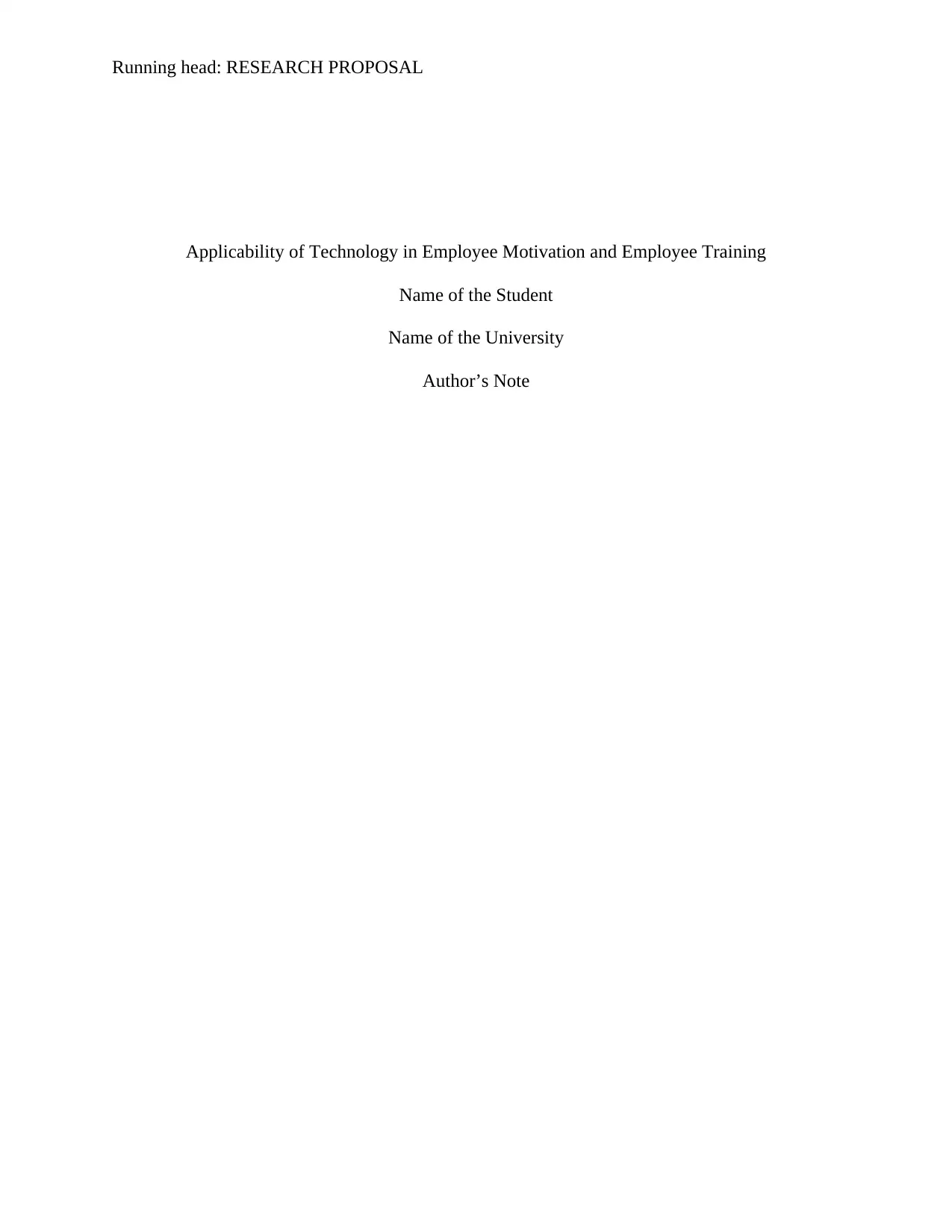
Running head: RESEARCH PROPOSAL
Applicability of Technology in Employee Motivation and Employee Training
Name of the Student
Name of the University
Author’s Note
Applicability of Technology in Employee Motivation and Employee Training
Name of the Student
Name of the University
Author’s Note
Secure Best Marks with AI Grader
Need help grading? Try our AI Grader for instant feedback on your assignments.
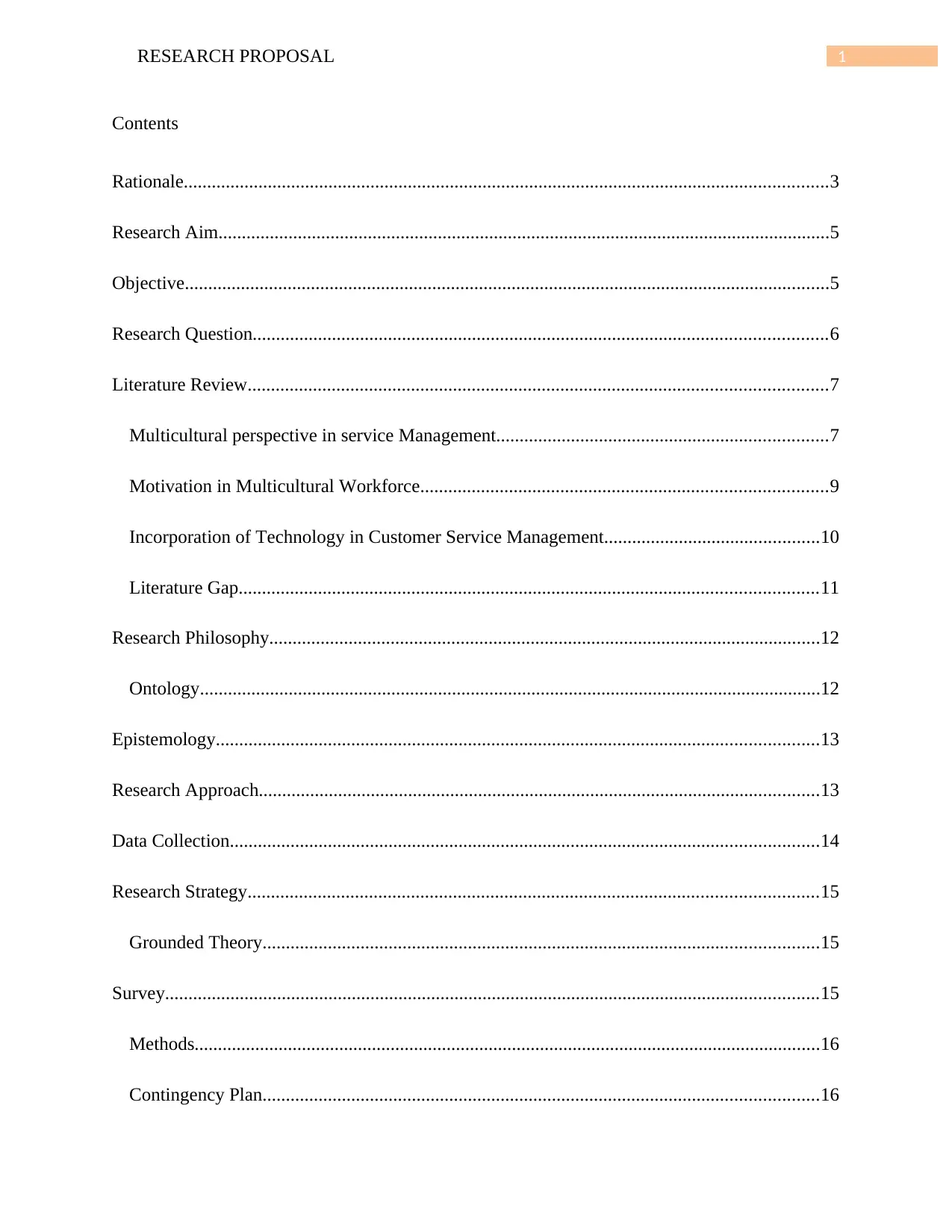
1RESEARCH PROPOSAL
Contents
Rationale..........................................................................................................................................3
Research Aim...................................................................................................................................5
Objective..........................................................................................................................................5
Research Question...........................................................................................................................6
Literature Review............................................................................................................................7
Multicultural perspective in service Management.......................................................................7
Motivation in Multicultural Workforce.......................................................................................9
Incorporation of Technology in Customer Service Management..............................................10
Literature Gap............................................................................................................................11
Research Philosophy......................................................................................................................12
Ontology.....................................................................................................................................12
Epistemology.................................................................................................................................13
Research Approach........................................................................................................................13
Data Collection..............................................................................................................................14
Research Strategy..........................................................................................................................15
Grounded Theory.......................................................................................................................15
Survey............................................................................................................................................15
Methods......................................................................................................................................16
Contingency Plan.......................................................................................................................16
Contents
Rationale..........................................................................................................................................3
Research Aim...................................................................................................................................5
Objective..........................................................................................................................................5
Research Question...........................................................................................................................6
Literature Review............................................................................................................................7
Multicultural perspective in service Management.......................................................................7
Motivation in Multicultural Workforce.......................................................................................9
Incorporation of Technology in Customer Service Management..............................................10
Literature Gap............................................................................................................................11
Research Philosophy......................................................................................................................12
Ontology.....................................................................................................................................12
Epistemology.................................................................................................................................13
Research Approach........................................................................................................................13
Data Collection..............................................................................................................................14
Research Strategy..........................................................................................................................15
Grounded Theory.......................................................................................................................15
Survey............................................................................................................................................15
Methods......................................................................................................................................16
Contingency Plan.......................................................................................................................16
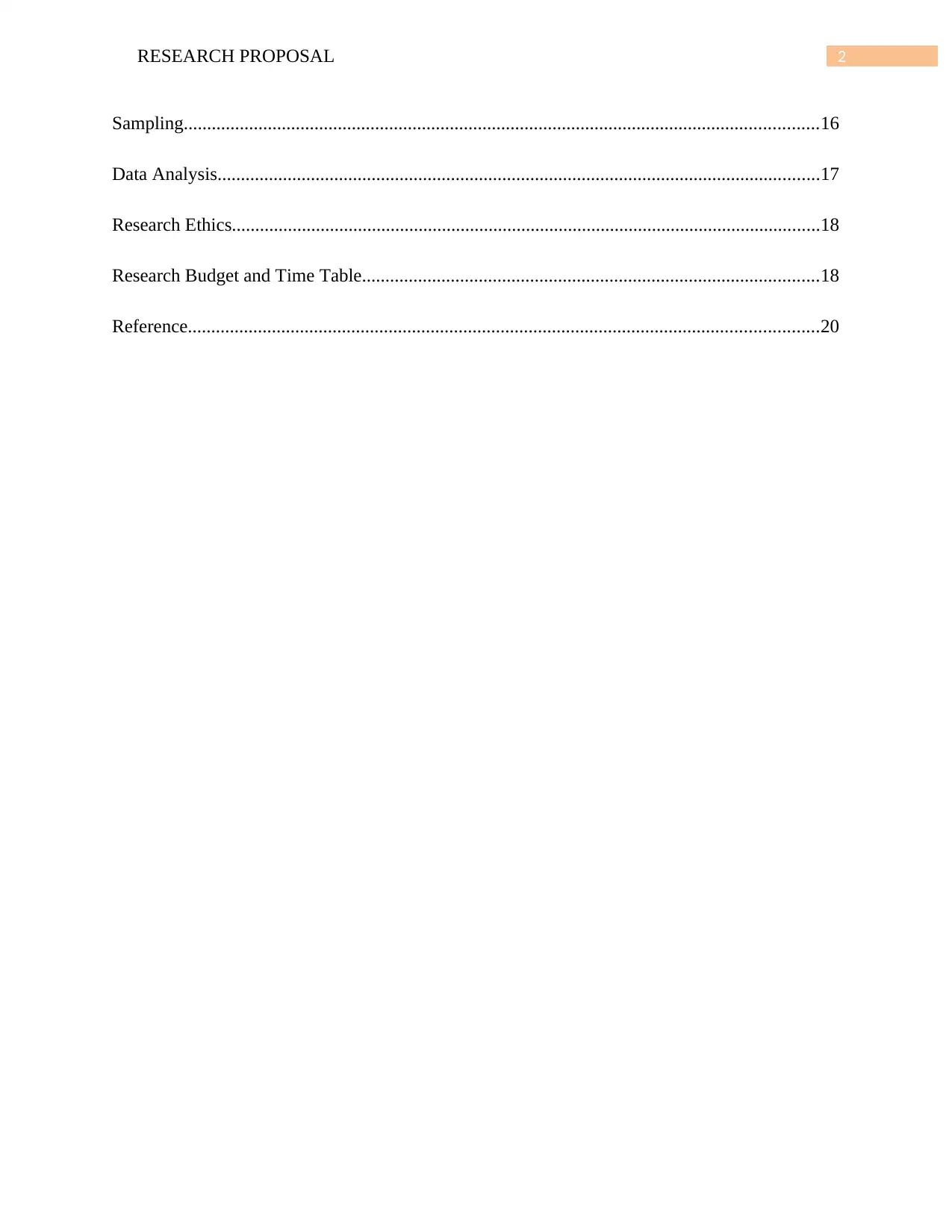
2RESEARCH PROPOSAL
Sampling........................................................................................................................................16
Data Analysis.................................................................................................................................17
Research Ethics..............................................................................................................................18
Research Budget and Time Table..................................................................................................18
Reference.......................................................................................................................................20
Sampling........................................................................................................................................16
Data Analysis.................................................................................................................................17
Research Ethics..............................................................................................................................18
Research Budget and Time Table..................................................................................................18
Reference.......................................................................................................................................20
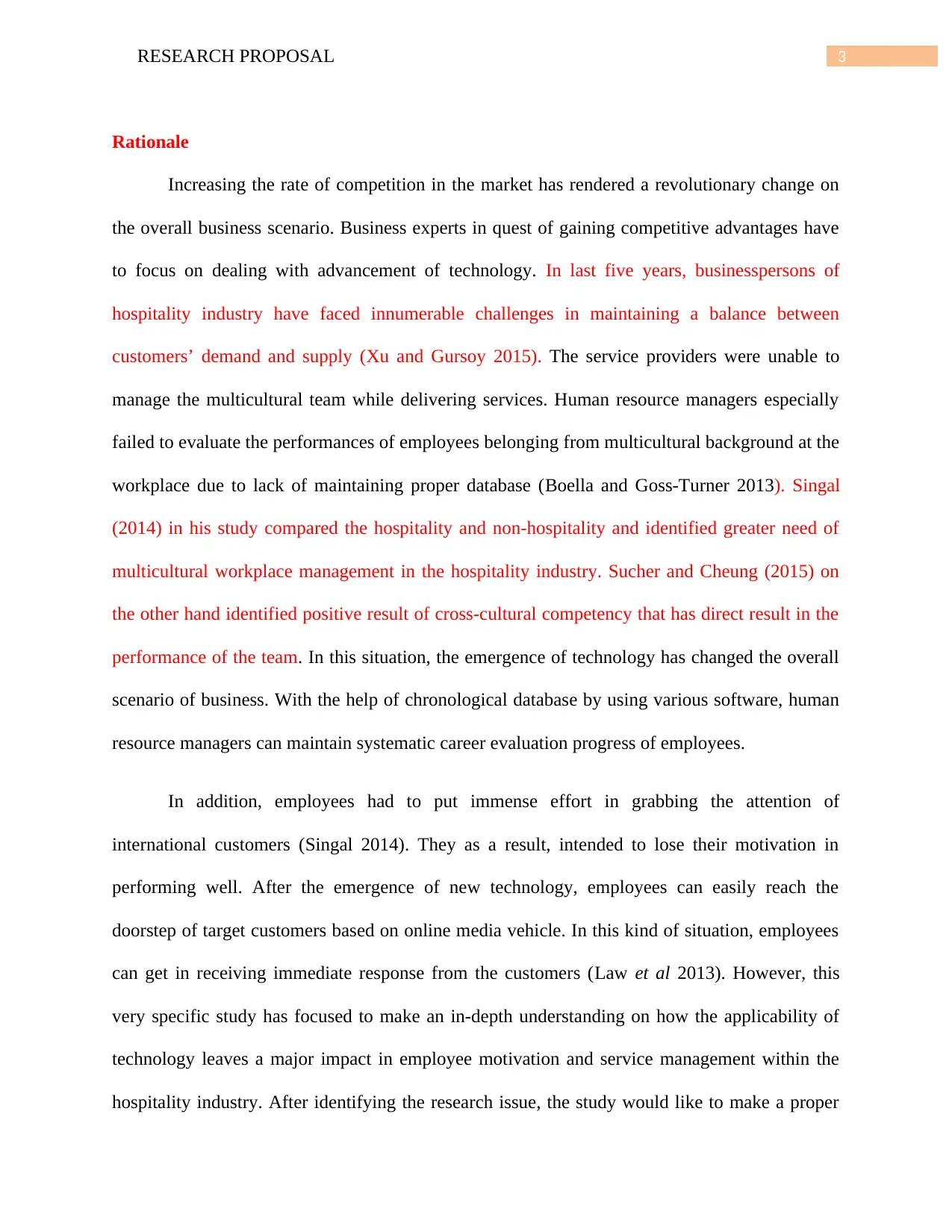
3RESEARCH PROPOSAL
Rationale
Increasing the rate of competition in the market has rendered a revolutionary change on
the overall business scenario. Business experts in quest of gaining competitive advantages have
to focus on dealing with advancement of technology. In last five years, businesspersons of
hospitality industry have faced innumerable challenges in maintaining a balance between
customers’ demand and supply (Xu and Gursoy 2015). The service providers were unable to
manage the multicultural team while delivering services. Human resource managers especially
failed to evaluate the performances of employees belonging from multicultural background at the
workplace due to lack of maintaining proper database (Boella and Goss-Turner 2013). Singal
(2014) in his study compared the hospitality and non-hospitality and identified greater need of
multicultural workplace management in the hospitality industry. Sucher and Cheung (2015) on
the other hand identified positive result of cross-cultural competency that has direct result in the
performance of the team. In this situation, the emergence of technology has changed the overall
scenario of business. With the help of chronological database by using various software, human
resource managers can maintain systematic career evaluation progress of employees.
In addition, employees had to put immense effort in grabbing the attention of
international customers (Singal 2014). They as a result, intended to lose their motivation in
performing well. After the emergence of new technology, employees can easily reach the
doorstep of target customers based on online media vehicle. In this kind of situation, employees
can get in receiving immediate response from the customers (Law et al 2013). However, this
very specific study has focused to make an in-depth understanding on how the applicability of
technology leaves a major impact in employee motivation and service management within the
hospitality industry. After identifying the research issue, the study would like to make a proper
Rationale
Increasing the rate of competition in the market has rendered a revolutionary change on
the overall business scenario. Business experts in quest of gaining competitive advantages have
to focus on dealing with advancement of technology. In last five years, businesspersons of
hospitality industry have faced innumerable challenges in maintaining a balance between
customers’ demand and supply (Xu and Gursoy 2015). The service providers were unable to
manage the multicultural team while delivering services. Human resource managers especially
failed to evaluate the performances of employees belonging from multicultural background at the
workplace due to lack of maintaining proper database (Boella and Goss-Turner 2013). Singal
(2014) in his study compared the hospitality and non-hospitality and identified greater need of
multicultural workplace management in the hospitality industry. Sucher and Cheung (2015) on
the other hand identified positive result of cross-cultural competency that has direct result in the
performance of the team. In this situation, the emergence of technology has changed the overall
scenario of business. With the help of chronological database by using various software, human
resource managers can maintain systematic career evaluation progress of employees.
In addition, employees had to put immense effort in grabbing the attention of
international customers (Singal 2014). They as a result, intended to lose their motivation in
performing well. After the emergence of new technology, employees can easily reach the
doorstep of target customers based on online media vehicle. In this kind of situation, employees
can get in receiving immediate response from the customers (Law et al 2013). However, this
very specific study has focused to make an in-depth understanding on how the applicability of
technology leaves a major impact in employee motivation and service management within the
hospitality industry. After identifying the research issue, the study would like to make a proper
Secure Best Marks with AI Grader
Need help grading? Try our AI Grader for instant feedback on your assignments.
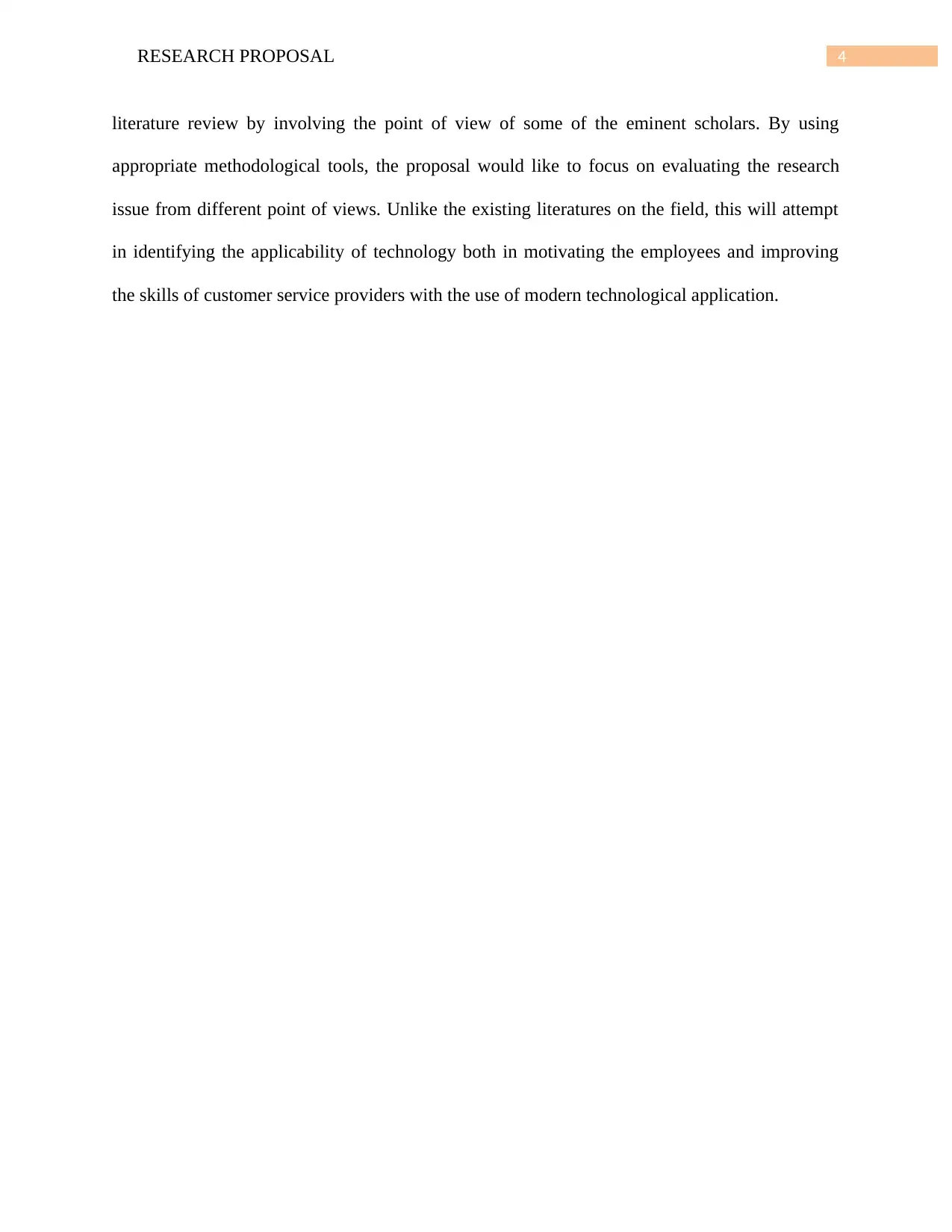
4RESEARCH PROPOSAL
literature review by involving the point of view of some of the eminent scholars. By using
appropriate methodological tools, the proposal would like to focus on evaluating the research
issue from different point of views. Unlike the existing literatures on the field, this will attempt
in identifying the applicability of technology both in motivating the employees and improving
the skills of customer service providers with the use of modern technological application.
literature review by involving the point of view of some of the eminent scholars. By using
appropriate methodological tools, the proposal would like to focus on evaluating the research
issue from different point of views. Unlike the existing literatures on the field, this will attempt
in identifying the applicability of technology both in motivating the employees and improving
the skills of customer service providers with the use of modern technological application.
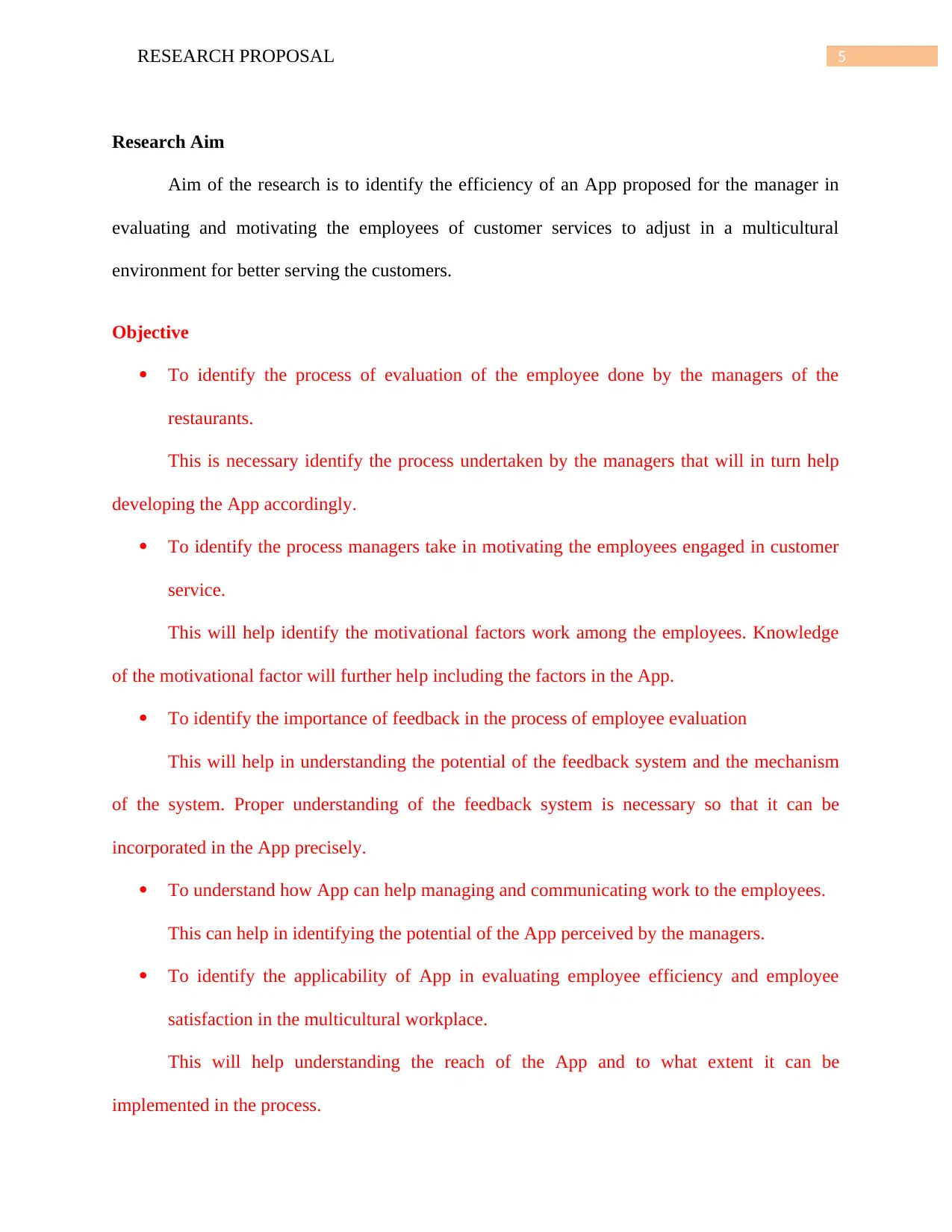
5RESEARCH PROPOSAL
Research Aim
Aim of the research is to identify the efficiency of an App proposed for the manager in
evaluating and motivating the employees of customer services to adjust in a multicultural
environment for better serving the customers.
Objective
To identify the process of evaluation of the employee done by the managers of the
restaurants.
This is necessary identify the process undertaken by the managers that will in turn help
developing the App accordingly.
To identify the process managers take in motivating the employees engaged in customer
service.
This will help identify the motivational factors work among the employees. Knowledge
of the motivational factor will further help including the factors in the App.
To identify the importance of feedback in the process of employee evaluation
This will help in understanding the potential of the feedback system and the mechanism
of the system. Proper understanding of the feedback system is necessary so that it can be
incorporated in the App precisely.
To understand how App can help managing and communicating work to the employees.
This can help in identifying the potential of the App perceived by the managers.
To identify the applicability of App in evaluating employee efficiency and employee
satisfaction in the multicultural workplace.
This will help understanding the reach of the App and to what extent it can be
implemented in the process.
Research Aim
Aim of the research is to identify the efficiency of an App proposed for the manager in
evaluating and motivating the employees of customer services to adjust in a multicultural
environment for better serving the customers.
Objective
To identify the process of evaluation of the employee done by the managers of the
restaurants.
This is necessary identify the process undertaken by the managers that will in turn help
developing the App accordingly.
To identify the process managers take in motivating the employees engaged in customer
service.
This will help identify the motivational factors work among the employees. Knowledge
of the motivational factor will further help including the factors in the App.
To identify the importance of feedback in the process of employee evaluation
This will help in understanding the potential of the feedback system and the mechanism
of the system. Proper understanding of the feedback system is necessary so that it can be
incorporated in the App precisely.
To understand how App can help managing and communicating work to the employees.
This can help in identifying the potential of the App perceived by the managers.
To identify the applicability of App in evaluating employee efficiency and employee
satisfaction in the multicultural workplace.
This will help understanding the reach of the App and to what extent it can be
implemented in the process.
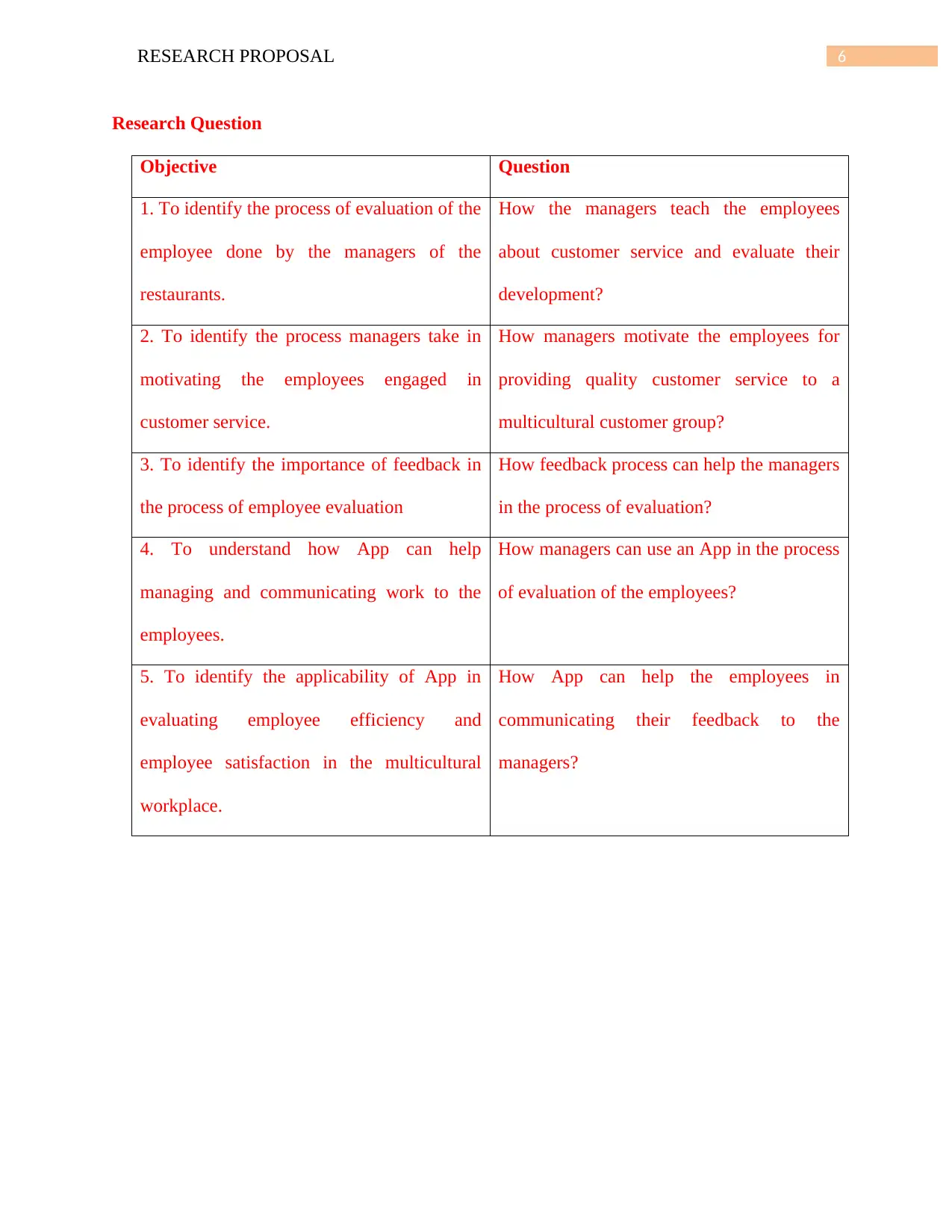
6RESEARCH PROPOSAL
Research Question
Objective Question
1. To identify the process of evaluation of the
employee done by the managers of the
restaurants.
How the managers teach the employees
about customer service and evaluate their
development?
2. To identify the process managers take in
motivating the employees engaged in
customer service.
How managers motivate the employees for
providing quality customer service to a
multicultural customer group?
3. To identify the importance of feedback in
the process of employee evaluation
How feedback process can help the managers
in the process of evaluation?
4. To understand how App can help
managing and communicating work to the
employees.
How managers can use an App in the process
of evaluation of the employees?
5. To identify the applicability of App in
evaluating employee efficiency and
employee satisfaction in the multicultural
workplace.
How App can help the employees in
communicating their feedback to the
managers?
Research Question
Objective Question
1. To identify the process of evaluation of the
employee done by the managers of the
restaurants.
How the managers teach the employees
about customer service and evaluate their
development?
2. To identify the process managers take in
motivating the employees engaged in
customer service.
How managers motivate the employees for
providing quality customer service to a
multicultural customer group?
3. To identify the importance of feedback in
the process of employee evaluation
How feedback process can help the managers
in the process of evaluation?
4. To understand how App can help
managing and communicating work to the
employees.
How managers can use an App in the process
of evaluation of the employees?
5. To identify the applicability of App in
evaluating employee efficiency and
employee satisfaction in the multicultural
workplace.
How App can help the employees in
communicating their feedback to the
managers?
Paraphrase This Document
Need a fresh take? Get an instant paraphrase of this document with our AI Paraphraser
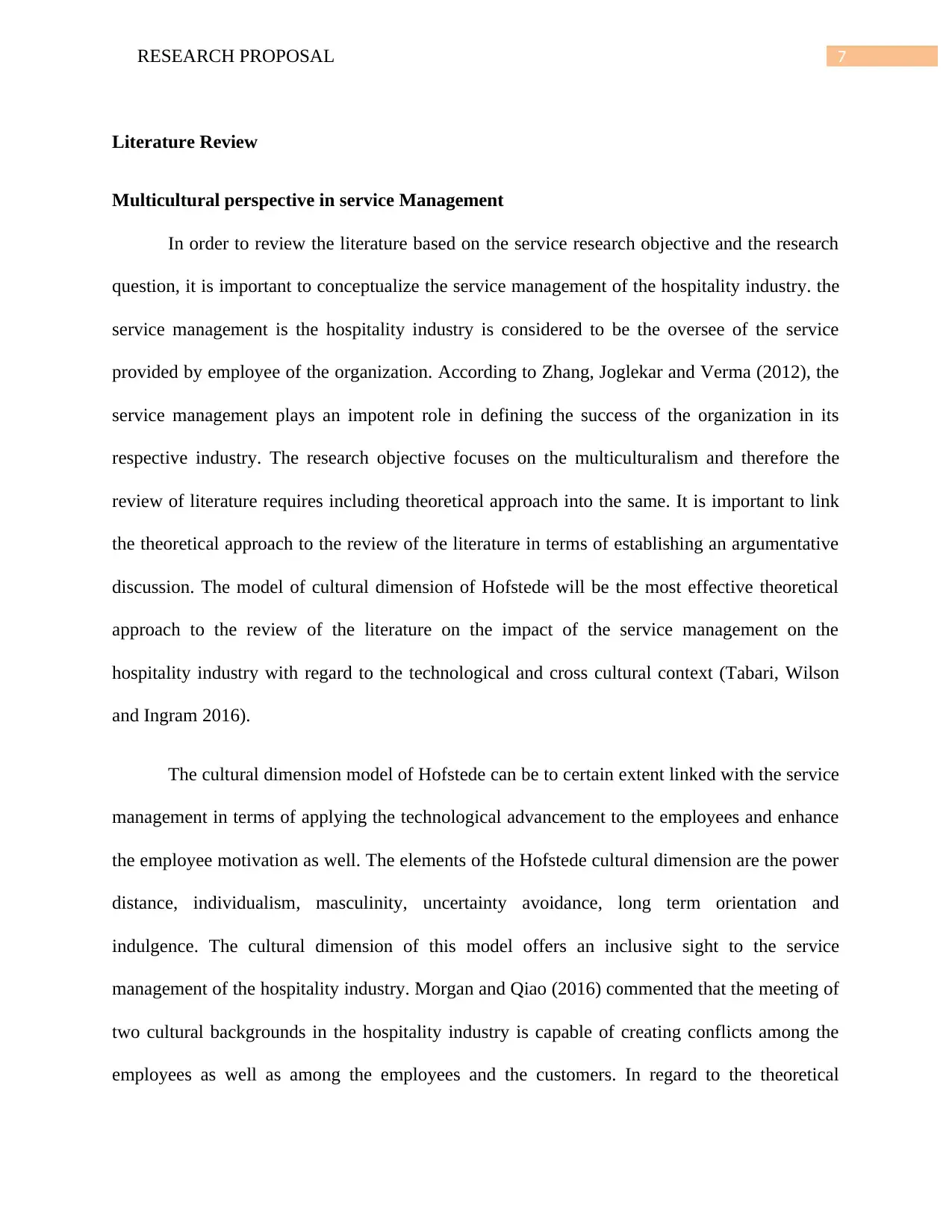
7RESEARCH PROPOSAL
Literature Review
Multicultural perspective in service Management
In order to review the literature based on the service research objective and the research
question, it is important to conceptualize the service management of the hospitality industry. the
service management is the hospitality industry is considered to be the oversee of the service
provided by employee of the organization. According to Zhang, Joglekar and Verma (2012), the
service management plays an impotent role in defining the success of the organization in its
respective industry. The research objective focuses on the multiculturalism and therefore the
review of literature requires including theoretical approach into the same. It is important to link
the theoretical approach to the review of the literature in terms of establishing an argumentative
discussion. The model of cultural dimension of Hofstede will be the most effective theoretical
approach to the review of the literature on the impact of the service management on the
hospitality industry with regard to the technological and cross cultural context (Tabari, Wilson
and Ingram 2016).
The cultural dimension model of Hofstede can be to certain extent linked with the service
management in terms of applying the technological advancement to the employees and enhance
the employee motivation as well. The elements of the Hofstede cultural dimension are the power
distance, individualism, masculinity, uncertainty avoidance, long term orientation and
indulgence. The cultural dimension of this model offers an inclusive sight to the service
management of the hospitality industry. Morgan and Qiao (2016) commented that the meeting of
two cultural backgrounds in the hospitality industry is capable of creating conflicts among the
employees as well as among the employees and the customers. In regard to the theoretical
Literature Review
Multicultural perspective in service Management
In order to review the literature based on the service research objective and the research
question, it is important to conceptualize the service management of the hospitality industry. the
service management is the hospitality industry is considered to be the oversee of the service
provided by employee of the organization. According to Zhang, Joglekar and Verma (2012), the
service management plays an impotent role in defining the success of the organization in its
respective industry. The research objective focuses on the multiculturalism and therefore the
review of literature requires including theoretical approach into the same. It is important to link
the theoretical approach to the review of the literature in terms of establishing an argumentative
discussion. The model of cultural dimension of Hofstede will be the most effective theoretical
approach to the review of the literature on the impact of the service management on the
hospitality industry with regard to the technological and cross cultural context (Tabari, Wilson
and Ingram 2016).
The cultural dimension model of Hofstede can be to certain extent linked with the service
management in terms of applying the technological advancement to the employees and enhance
the employee motivation as well. The elements of the Hofstede cultural dimension are the power
distance, individualism, masculinity, uncertainty avoidance, long term orientation and
indulgence. The cultural dimension of this model offers an inclusive sight to the service
management of the hospitality industry. Morgan and Qiao (2016) commented that the meeting of
two cultural backgrounds in the hospitality industry is capable of creating conflicts among the
employees as well as among the employees and the customers. In regard to the theoretical
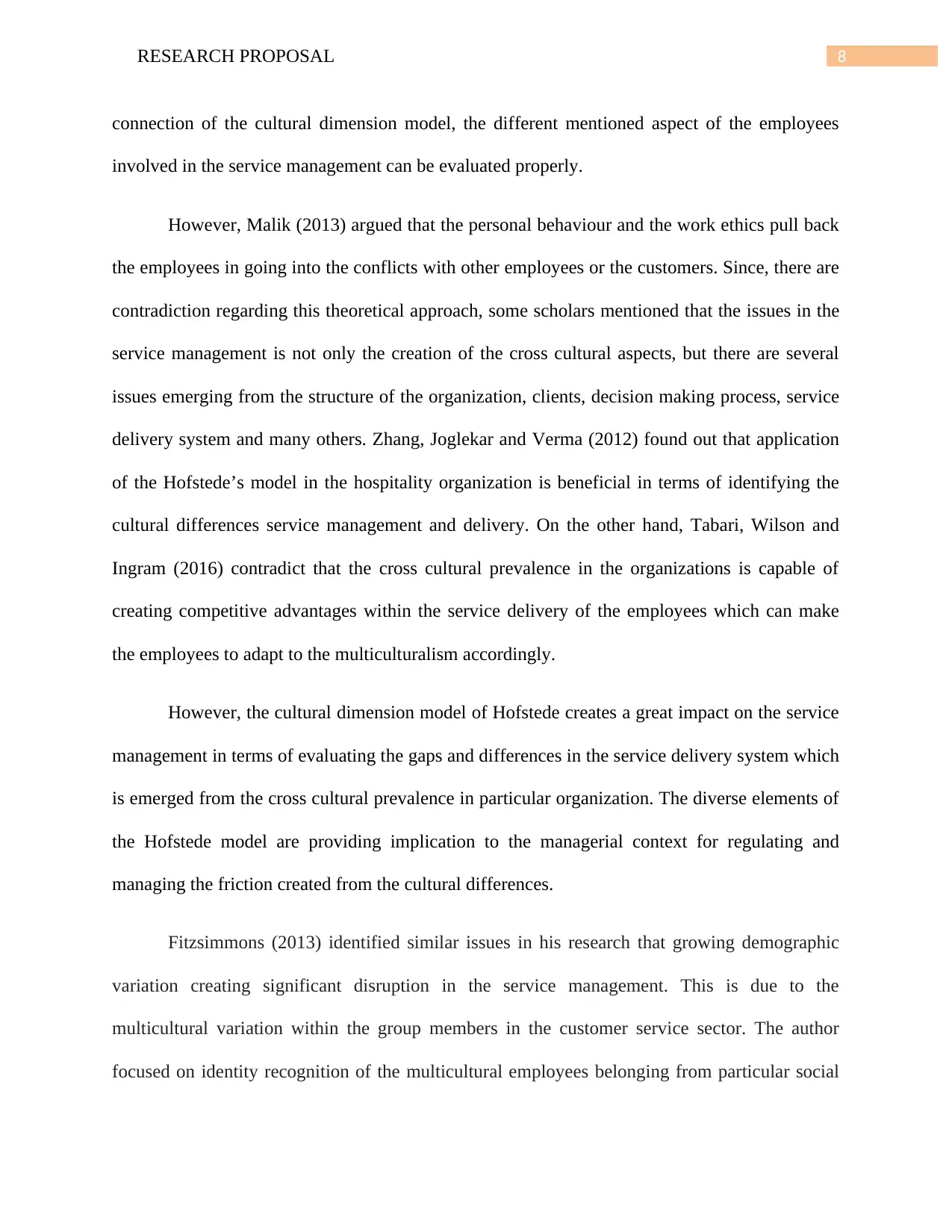
8RESEARCH PROPOSAL
connection of the cultural dimension model, the different mentioned aspect of the employees
involved in the service management can be evaluated properly.
However, Malik (2013) argued that the personal behaviour and the work ethics pull back
the employees in going into the conflicts with other employees or the customers. Since, there are
contradiction regarding this theoretical approach, some scholars mentioned that the issues in the
service management is not only the creation of the cross cultural aspects, but there are several
issues emerging from the structure of the organization, clients, decision making process, service
delivery system and many others. Zhang, Joglekar and Verma (2012) found out that application
of the Hofstede’s model in the hospitality organization is beneficial in terms of identifying the
cultural differences service management and delivery. On the other hand, Tabari, Wilson and
Ingram (2016) contradict that the cross cultural prevalence in the organizations is capable of
creating competitive advantages within the service delivery of the employees which can make
the employees to adapt to the multiculturalism accordingly.
However, the cultural dimension model of Hofstede creates a great impact on the service
management in terms of evaluating the gaps and differences in the service delivery system which
is emerged from the cross cultural prevalence in particular organization. The diverse elements of
the Hofstede model are providing implication to the managerial context for regulating and
managing the friction created from the cultural differences.
Fitzsimmons (2013) identified similar issues in his research that growing demographic
variation creating significant disruption in the service management. This is due to the
multicultural variation within the group members in the customer service sector. The author
focused on identity recognition of the multicultural employees belonging from particular social
connection of the cultural dimension model, the different mentioned aspect of the employees
involved in the service management can be evaluated properly.
However, Malik (2013) argued that the personal behaviour and the work ethics pull back
the employees in going into the conflicts with other employees or the customers. Since, there are
contradiction regarding this theoretical approach, some scholars mentioned that the issues in the
service management is not only the creation of the cross cultural aspects, but there are several
issues emerging from the structure of the organization, clients, decision making process, service
delivery system and many others. Zhang, Joglekar and Verma (2012) found out that application
of the Hofstede’s model in the hospitality organization is beneficial in terms of identifying the
cultural differences service management and delivery. On the other hand, Tabari, Wilson and
Ingram (2016) contradict that the cross cultural prevalence in the organizations is capable of
creating competitive advantages within the service delivery of the employees which can make
the employees to adapt to the multiculturalism accordingly.
However, the cultural dimension model of Hofstede creates a great impact on the service
management in terms of evaluating the gaps and differences in the service delivery system which
is emerged from the cross cultural prevalence in particular organization. The diverse elements of
the Hofstede model are providing implication to the managerial context for regulating and
managing the friction created from the cultural differences.
Fitzsimmons (2013) identified similar issues in his research that growing demographic
variation creating significant disruption in the service management. This is due to the
multicultural variation within the group members in the customer service sector. The author
focused on identity recognition of the multicultural employees belonging from particular social
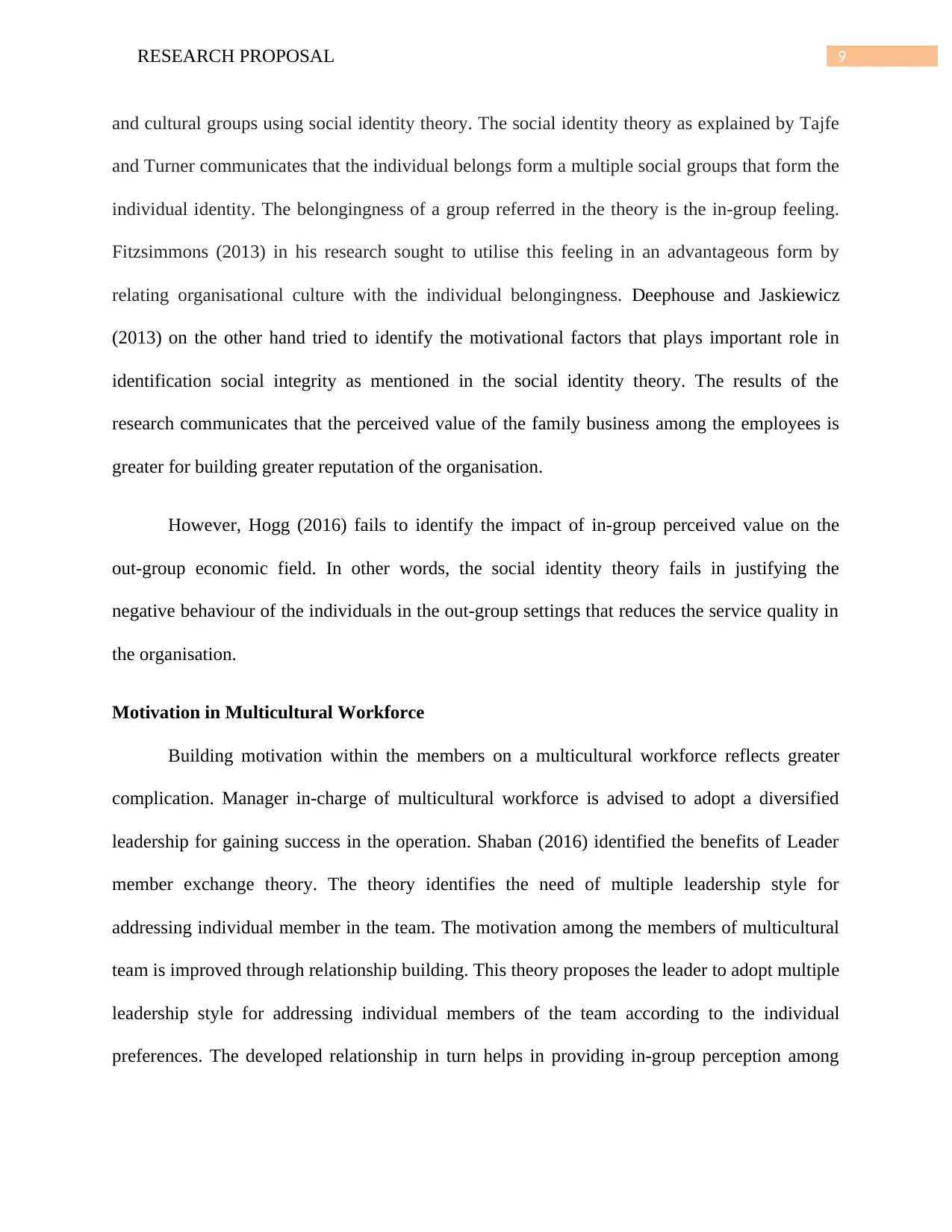
9RESEARCH PROPOSAL
and cultural groups using social identity theory. The social identity theory as explained by Tajfe
and Turner communicates that the individual belongs form a multiple social groups that form the
individual identity. The belongingness of a group referred in the theory is the in-group feeling.
Fitzsimmons (2013) in his research sought to utilise this feeling in an advantageous form by
relating organisational culture with the individual belongingness. Deephouse and Jaskiewicz
(2013) on the other hand tried to identify the motivational factors that plays important role in
identification social integrity as mentioned in the social identity theory. The results of the
research communicates that the perceived value of the family business among the employees is
greater for building greater reputation of the organisation.
However, Hogg (2016) fails to identify the impact of in-group perceived value on the
out-group economic field. In other words, the social identity theory fails in justifying the
negative behaviour of the individuals in the out-group settings that reduces the service quality in
the organisation.
Motivation in Multicultural Workforce
Building motivation within the members on a multicultural workforce reflects greater
complication. Manager in-charge of multicultural workforce is advised to adopt a diversified
leadership for gaining success in the operation. Shaban (2016) identified the benefits of Leader
member exchange theory. The theory identifies the need of multiple leadership style for
addressing individual member in the team. The motivation among the members of multicultural
team is improved through relationship building. This theory proposes the leader to adopt multiple
leadership style for addressing individual members of the team according to the individual
preferences. The developed relationship in turn helps in providing in-group perception among
and cultural groups using social identity theory. The social identity theory as explained by Tajfe
and Turner communicates that the individual belongs form a multiple social groups that form the
individual identity. The belongingness of a group referred in the theory is the in-group feeling.
Fitzsimmons (2013) in his research sought to utilise this feeling in an advantageous form by
relating organisational culture with the individual belongingness. Deephouse and Jaskiewicz
(2013) on the other hand tried to identify the motivational factors that plays important role in
identification social integrity as mentioned in the social identity theory. The results of the
research communicates that the perceived value of the family business among the employees is
greater for building greater reputation of the organisation.
However, Hogg (2016) fails to identify the impact of in-group perceived value on the
out-group economic field. In other words, the social identity theory fails in justifying the
negative behaviour of the individuals in the out-group settings that reduces the service quality in
the organisation.
Motivation in Multicultural Workforce
Building motivation within the members on a multicultural workforce reflects greater
complication. Manager in-charge of multicultural workforce is advised to adopt a diversified
leadership for gaining success in the operation. Shaban (2016) identified the benefits of Leader
member exchange theory. The theory identifies the need of multiple leadership style for
addressing individual member in the team. The motivation among the members of multicultural
team is improved through relationship building. This theory proposes the leader to adopt multiple
leadership style for addressing individual members of the team according to the individual
preferences. The developed relationship in turn helps in providing in-group perception among
Secure Best Marks with AI Grader
Need help grading? Try our AI Grader for instant feedback on your assignments.
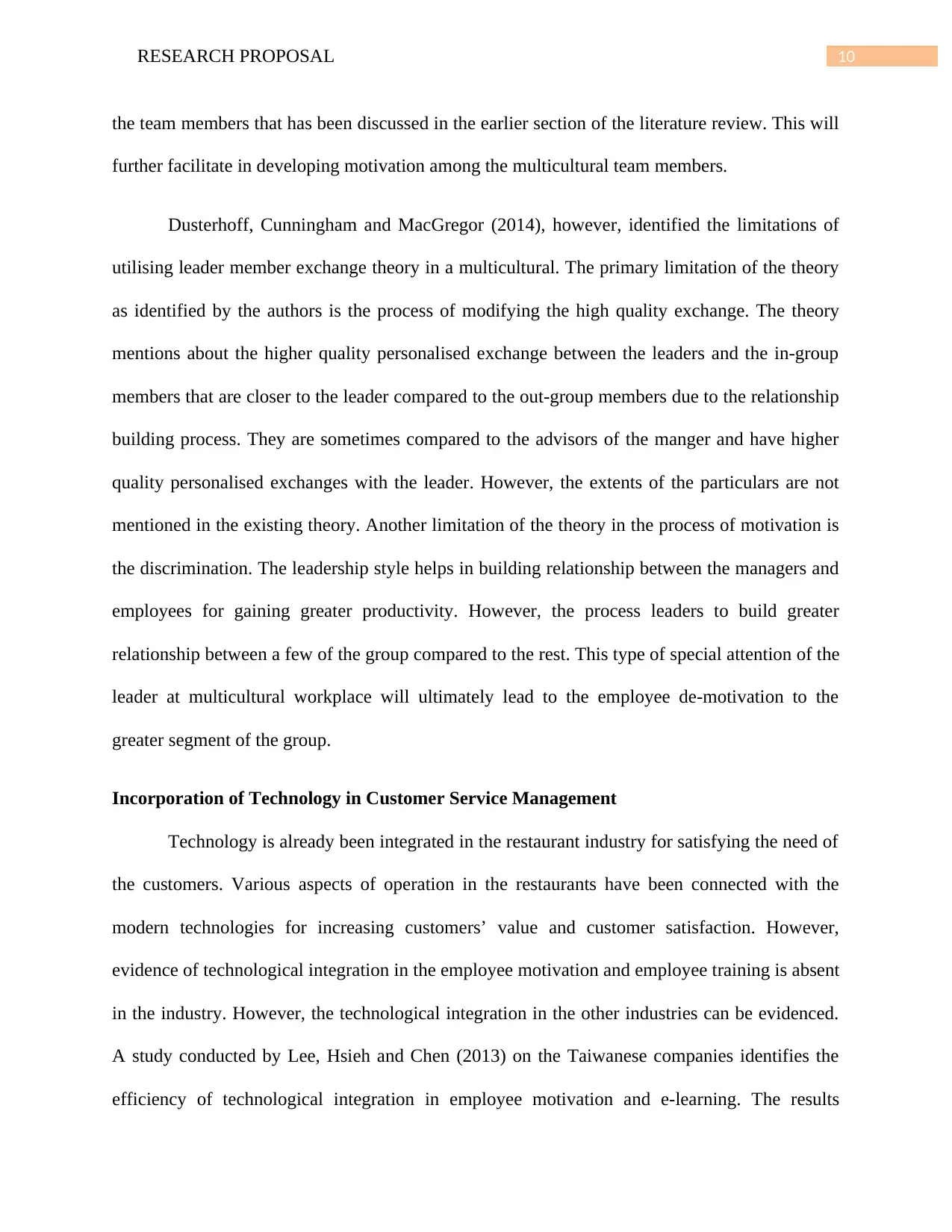
10RESEARCH PROPOSAL
the team members that has been discussed in the earlier section of the literature review. This will
further facilitate in developing motivation among the multicultural team members.
Dusterhoff, Cunningham and MacGregor (2014), however, identified the limitations of
utilising leader member exchange theory in a multicultural. The primary limitation of the theory
as identified by the authors is the process of modifying the high quality exchange. The theory
mentions about the higher quality personalised exchange between the leaders and the in-group
members that are closer to the leader compared to the out-group members due to the relationship
building process. They are sometimes compared to the advisors of the manger and have higher
quality personalised exchanges with the leader. However, the extents of the particulars are not
mentioned in the existing theory. Another limitation of the theory in the process of motivation is
the discrimination. The leadership style helps in building relationship between the managers and
employees for gaining greater productivity. However, the process leaders to build greater
relationship between a few of the group compared to the rest. This type of special attention of the
leader at multicultural workplace will ultimately lead to the employee de-motivation to the
greater segment of the group.
Incorporation of Technology in Customer Service Management
Technology is already been integrated in the restaurant industry for satisfying the need of
the customers. Various aspects of operation in the restaurants have been connected with the
modern technologies for increasing customers’ value and customer satisfaction. However,
evidence of technological integration in the employee motivation and employee training is absent
in the industry. However, the technological integration in the other industries can be evidenced.
A study conducted by Lee, Hsieh and Chen (2013) on the Taiwanese companies identifies the
efficiency of technological integration in employee motivation and e-learning. The results
the team members that has been discussed in the earlier section of the literature review. This will
further facilitate in developing motivation among the multicultural team members.
Dusterhoff, Cunningham and MacGregor (2014), however, identified the limitations of
utilising leader member exchange theory in a multicultural. The primary limitation of the theory
as identified by the authors is the process of modifying the high quality exchange. The theory
mentions about the higher quality personalised exchange between the leaders and the in-group
members that are closer to the leader compared to the out-group members due to the relationship
building process. They are sometimes compared to the advisors of the manger and have higher
quality personalised exchanges with the leader. However, the extents of the particulars are not
mentioned in the existing theory. Another limitation of the theory in the process of motivation is
the discrimination. The leadership style helps in building relationship between the managers and
employees for gaining greater productivity. However, the process leaders to build greater
relationship between a few of the group compared to the rest. This type of special attention of the
leader at multicultural workplace will ultimately lead to the employee de-motivation to the
greater segment of the group.
Incorporation of Technology in Customer Service Management
Technology is already been integrated in the restaurant industry for satisfying the need of
the customers. Various aspects of operation in the restaurants have been connected with the
modern technologies for increasing customers’ value and customer satisfaction. However,
evidence of technological integration in the employee motivation and employee training is absent
in the industry. However, the technological integration in the other industries can be evidenced.
A study conducted by Lee, Hsieh and Chen (2013) on the Taiwanese companies identifies the
efficiency of technological integration in employee motivation and e-learning. The results
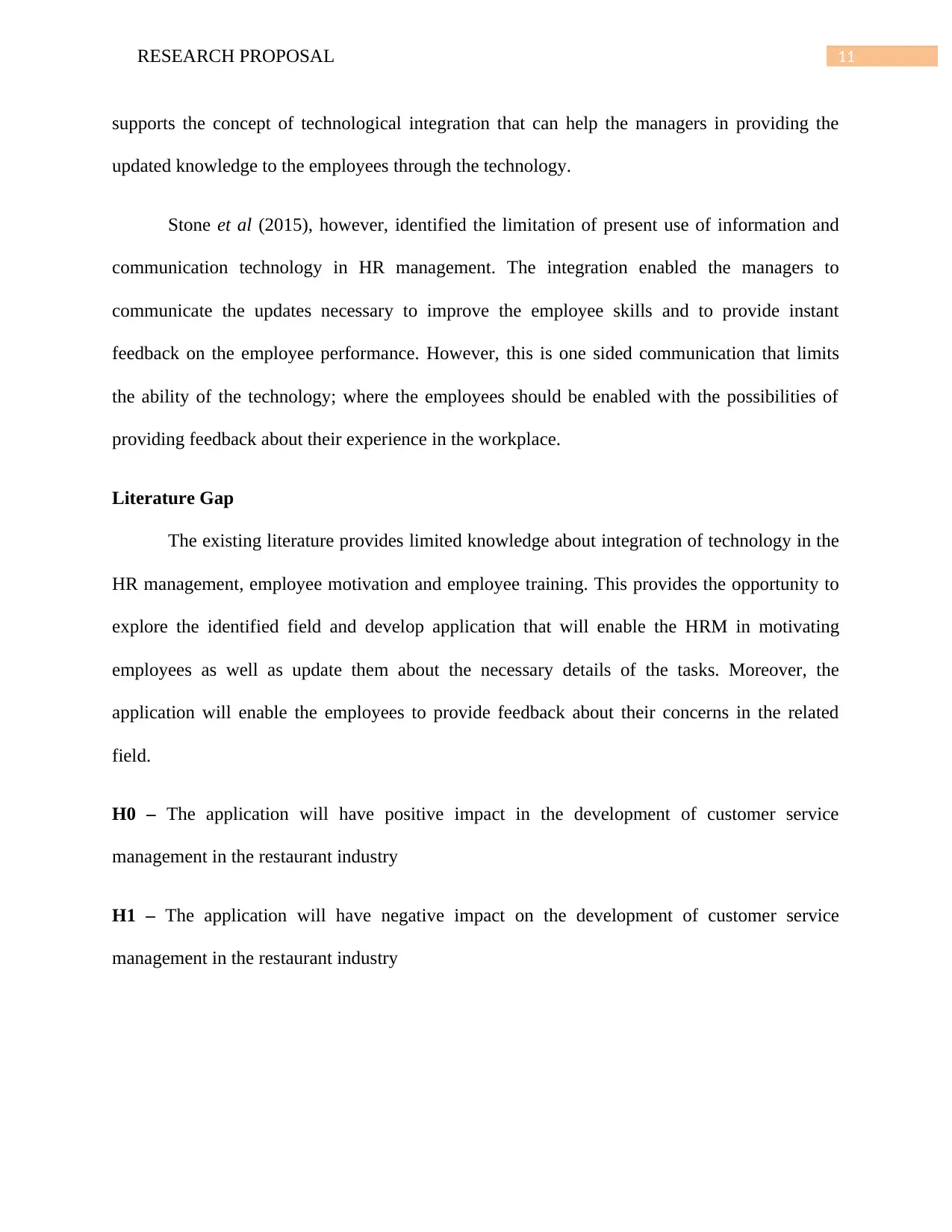
11RESEARCH PROPOSAL
supports the concept of technological integration that can help the managers in providing the
updated knowledge to the employees through the technology.
Stone et al (2015), however, identified the limitation of present use of information and
communication technology in HR management. The integration enabled the managers to
communicate the updates necessary to improve the employee skills and to provide instant
feedback on the employee performance. However, this is one sided communication that limits
the ability of the technology; where the employees should be enabled with the possibilities of
providing feedback about their experience in the workplace.
Literature Gap
The existing literature provides limited knowledge about integration of technology in the
HR management, employee motivation and employee training. This provides the opportunity to
explore the identified field and develop application that will enable the HRM in motivating
employees as well as update them about the necessary details of the tasks. Moreover, the
application will enable the employees to provide feedback about their concerns in the related
field.
H0 – The application will have positive impact in the development of customer service
management in the restaurant industry
H1 – The application will have negative impact on the development of customer service
management in the restaurant industry
supports the concept of technological integration that can help the managers in providing the
updated knowledge to the employees through the technology.
Stone et al (2015), however, identified the limitation of present use of information and
communication technology in HR management. The integration enabled the managers to
communicate the updates necessary to improve the employee skills and to provide instant
feedback on the employee performance. However, this is one sided communication that limits
the ability of the technology; where the employees should be enabled with the possibilities of
providing feedback about their experience in the workplace.
Literature Gap
The existing literature provides limited knowledge about integration of technology in the
HR management, employee motivation and employee training. This provides the opportunity to
explore the identified field and develop application that will enable the HRM in motivating
employees as well as update them about the necessary details of the tasks. Moreover, the
application will enable the employees to provide feedback about their concerns in the related
field.
H0 – The application will have positive impact in the development of customer service
management in the restaurant industry
H1 – The application will have negative impact on the development of customer service
management in the restaurant industry
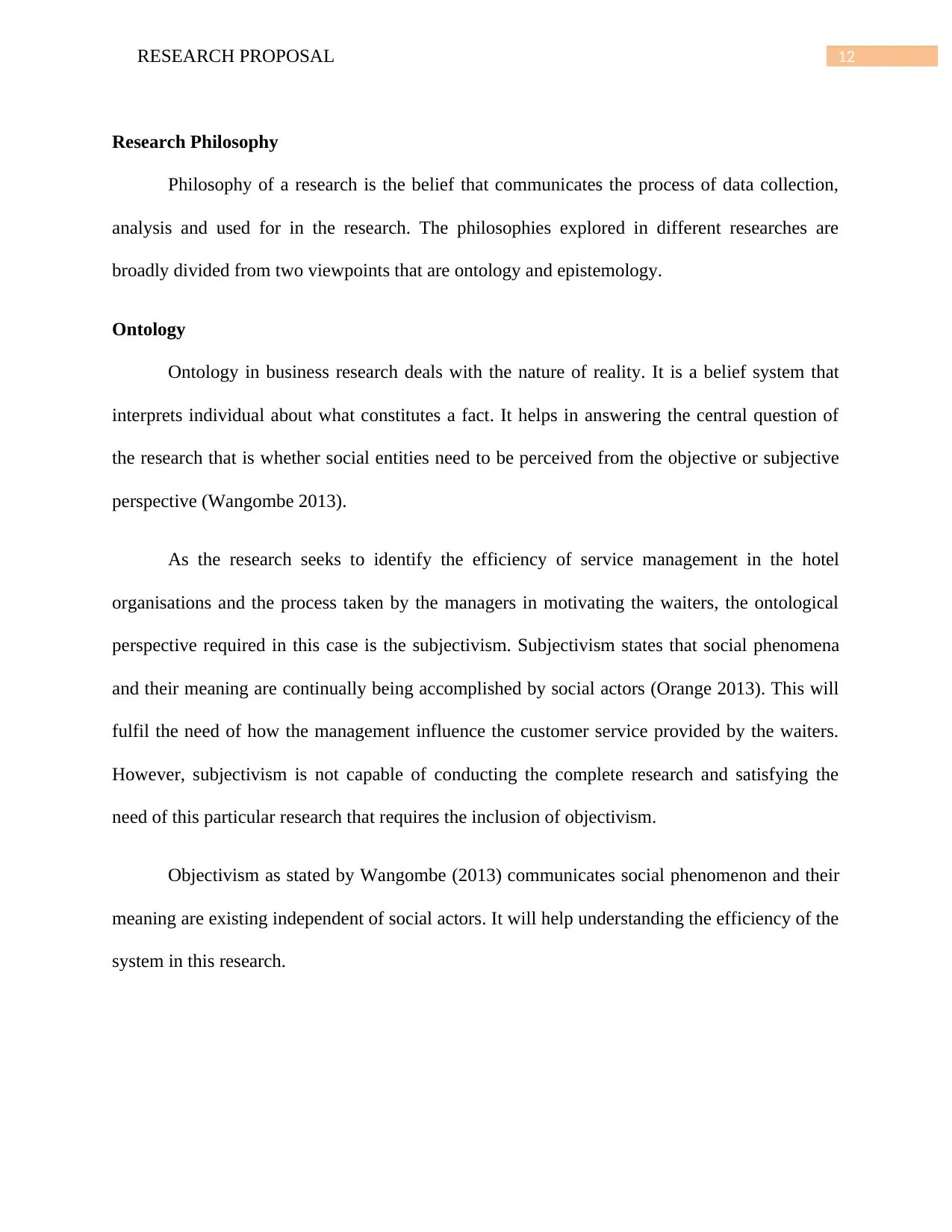
12RESEARCH PROPOSAL
Research Philosophy
Philosophy of a research is the belief that communicates the process of data collection,
analysis and used for in the research. The philosophies explored in different researches are
broadly divided from two viewpoints that are ontology and epistemology.
Ontology
Ontology in business research deals with the nature of reality. It is a belief system that
interprets individual about what constitutes a fact. It helps in answering the central question of
the research that is whether social entities need to be perceived from the objective or subjective
perspective (Wangombe 2013).
As the research seeks to identify the efficiency of service management in the hotel
organisations and the process taken by the managers in motivating the waiters, the ontological
perspective required in this case is the subjectivism. Subjectivism states that social phenomena
and their meaning are continually being accomplished by social actors (Orange 2013). This will
fulfil the need of how the management influence the customer service provided by the waiters.
However, subjectivism is not capable of conducting the complete research and satisfying the
need of this particular research that requires the inclusion of objectivism.
Objectivism as stated by Wangombe (2013) communicates social phenomenon and their
meaning are existing independent of social actors. It will help understanding the efficiency of the
system in this research.
Research Philosophy
Philosophy of a research is the belief that communicates the process of data collection,
analysis and used for in the research. The philosophies explored in different researches are
broadly divided from two viewpoints that are ontology and epistemology.
Ontology
Ontology in business research deals with the nature of reality. It is a belief system that
interprets individual about what constitutes a fact. It helps in answering the central question of
the research that is whether social entities need to be perceived from the objective or subjective
perspective (Wangombe 2013).
As the research seeks to identify the efficiency of service management in the hotel
organisations and the process taken by the managers in motivating the waiters, the ontological
perspective required in this case is the subjectivism. Subjectivism states that social phenomena
and their meaning are continually being accomplished by social actors (Orange 2013). This will
fulfil the need of how the management influence the customer service provided by the waiters.
However, subjectivism is not capable of conducting the complete research and satisfying the
need of this particular research that requires the inclusion of objectivism.
Objectivism as stated by Wangombe (2013) communicates social phenomenon and their
meaning are existing independent of social actors. It will help understanding the efficiency of the
system in this research.
Paraphrase This Document
Need a fresh take? Get an instant paraphrase of this document with our AI Paraphraser
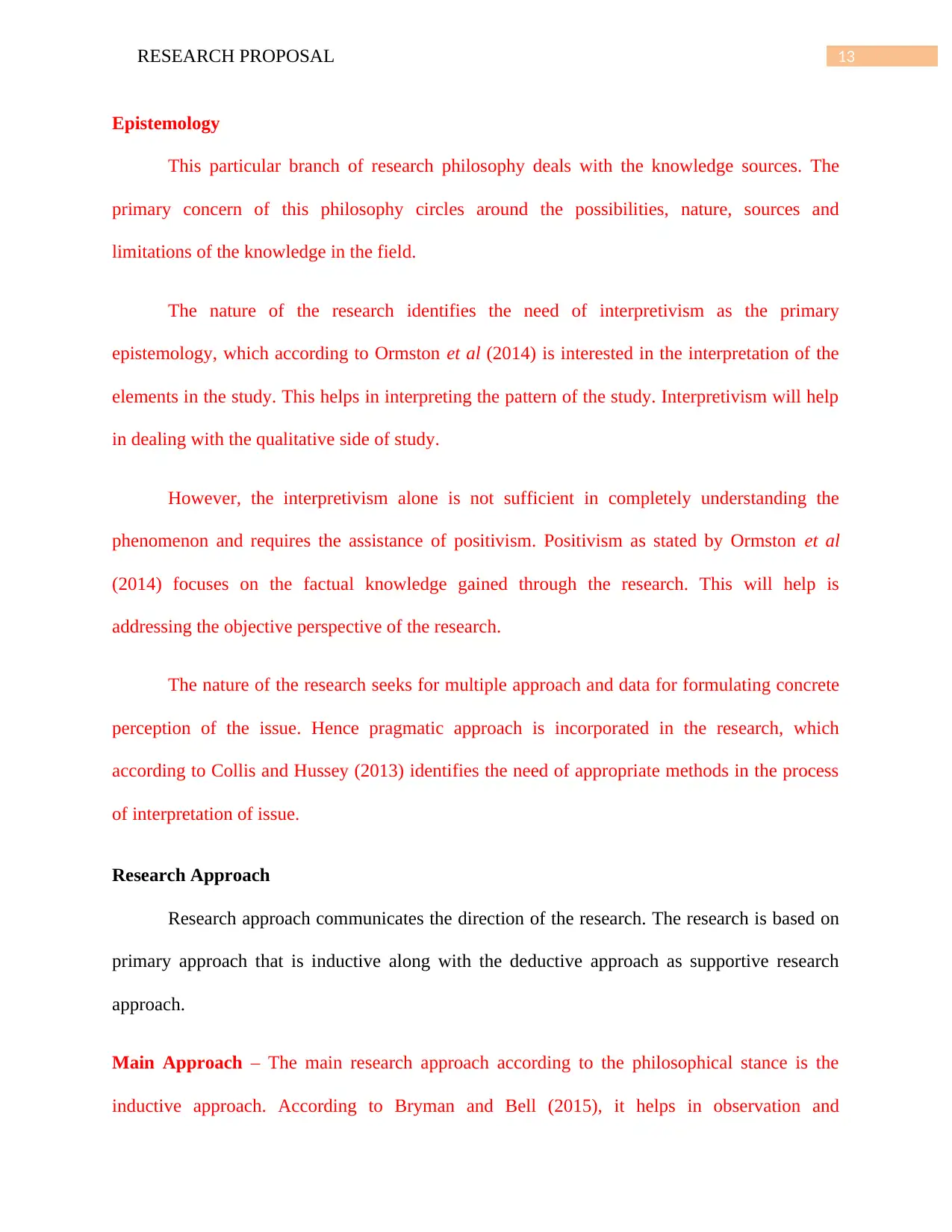
13RESEARCH PROPOSAL
Epistemology
This particular branch of research philosophy deals with the knowledge sources. The
primary concern of this philosophy circles around the possibilities, nature, sources and
limitations of the knowledge in the field.
The nature of the research identifies the need of interpretivism as the primary
epistemology, which according to Ormston et al (2014) is interested in the interpretation of the
elements in the study. This helps in interpreting the pattern of the study. Interpretivism will help
in dealing with the qualitative side of study.
However, the interpretivism alone is not sufficient in completely understanding the
phenomenon and requires the assistance of positivism. Positivism as stated by Ormston et al
(2014) focuses on the factual knowledge gained through the research. This will help is
addressing the objective perspective of the research.
The nature of the research seeks for multiple approach and data for formulating concrete
perception of the issue. Hence pragmatic approach is incorporated in the research, which
according to Collis and Hussey (2013) identifies the need of appropriate methods in the process
of interpretation of issue.
Research Approach
Research approach communicates the direction of the research. The research is based on
primary approach that is inductive along with the deductive approach as supportive research
approach.
Main Approach – The main research approach according to the philosophical stance is the
inductive approach. According to Bryman and Bell (2015), it helps in observation and
Epistemology
This particular branch of research philosophy deals with the knowledge sources. The
primary concern of this philosophy circles around the possibilities, nature, sources and
limitations of the knowledge in the field.
The nature of the research identifies the need of interpretivism as the primary
epistemology, which according to Ormston et al (2014) is interested in the interpretation of the
elements in the study. This helps in interpreting the pattern of the study. Interpretivism will help
in dealing with the qualitative side of study.
However, the interpretivism alone is not sufficient in completely understanding the
phenomenon and requires the assistance of positivism. Positivism as stated by Ormston et al
(2014) focuses on the factual knowledge gained through the research. This will help is
addressing the objective perspective of the research.
The nature of the research seeks for multiple approach and data for formulating concrete
perception of the issue. Hence pragmatic approach is incorporated in the research, which
according to Collis and Hussey (2013) identifies the need of appropriate methods in the process
of interpretation of issue.
Research Approach
Research approach communicates the direction of the research. The research is based on
primary approach that is inductive along with the deductive approach as supportive research
approach.
Main Approach – The main research approach according to the philosophical stance is the
inductive approach. According to Bryman and Bell (2015), it helps in observation and
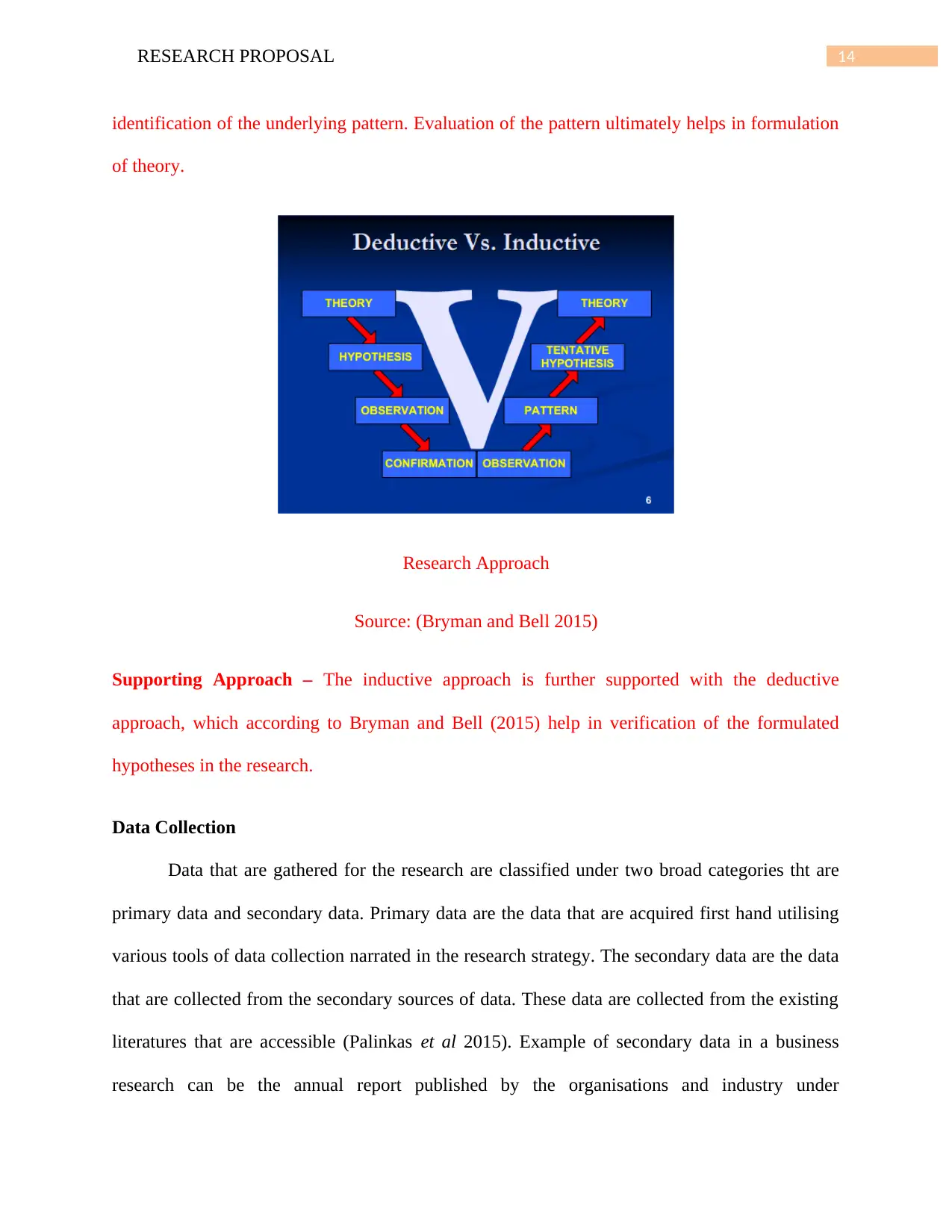
14RESEARCH PROPOSAL
identification of the underlying pattern. Evaluation of the pattern ultimately helps in formulation
of theory.
Research Approach
Source: (Bryman and Bell 2015)
Supporting Approach – The inductive approach is further supported with the deductive
approach, which according to Bryman and Bell (2015) help in verification of the formulated
hypotheses in the research.
Data Collection
Data that are gathered for the research are classified under two broad categories tht are
primary data and secondary data. Primary data are the data that are acquired first hand utilising
various tools of data collection narrated in the research strategy. The secondary data are the data
that are collected from the secondary sources of data. These data are collected from the existing
literatures that are accessible (Palinkas et al 2015). Example of secondary data in a business
research can be the annual report published by the organisations and industry under
identification of the underlying pattern. Evaluation of the pattern ultimately helps in formulation
of theory.
Research Approach
Source: (Bryman and Bell 2015)
Supporting Approach – The inductive approach is further supported with the deductive
approach, which according to Bryman and Bell (2015) help in verification of the formulated
hypotheses in the research.
Data Collection
Data that are gathered for the research are classified under two broad categories tht are
primary data and secondary data. Primary data are the data that are acquired first hand utilising
various tools of data collection narrated in the research strategy. The secondary data are the data
that are collected from the secondary sources of data. These data are collected from the existing
literatures that are accessible (Palinkas et al 2015). Example of secondary data in a business
research can be the annual report published by the organisations and industry under
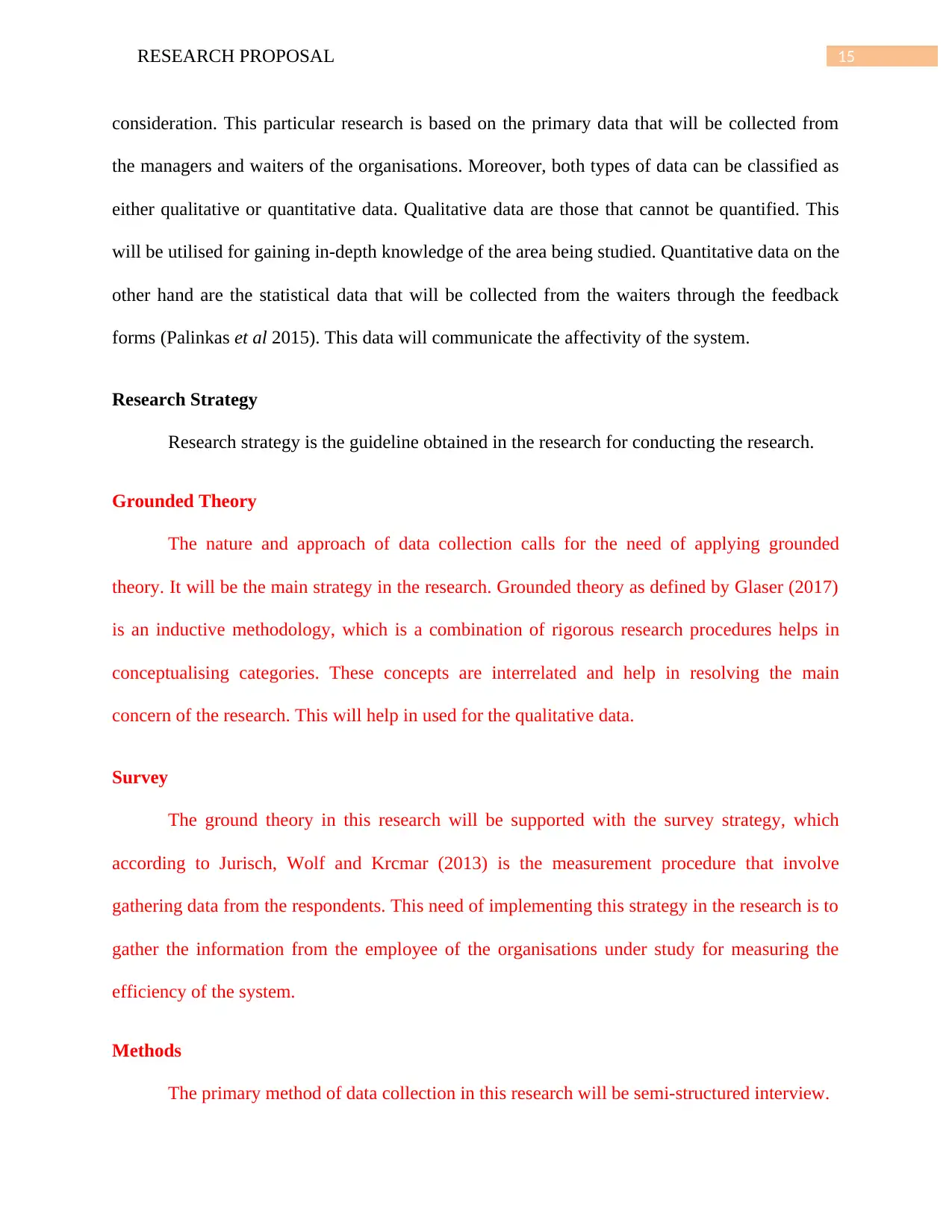
15RESEARCH PROPOSAL
consideration. This particular research is based on the primary data that will be collected from
the managers and waiters of the organisations. Moreover, both types of data can be classified as
either qualitative or quantitative data. Qualitative data are those that cannot be quantified. This
will be utilised for gaining in-depth knowledge of the area being studied. Quantitative data on the
other hand are the statistical data that will be collected from the waiters through the feedback
forms (Palinkas et al 2015). This data will communicate the affectivity of the system.
Research Strategy
Research strategy is the guideline obtained in the research for conducting the research.
Grounded Theory
The nature and approach of data collection calls for the need of applying grounded
theory. It will be the main strategy in the research. Grounded theory as defined by Glaser (2017)
is an inductive methodology, which is a combination of rigorous research procedures helps in
conceptualising categories. These concepts are interrelated and help in resolving the main
concern of the research. This will help in used for the qualitative data.
Survey
The ground theory in this research will be supported with the survey strategy, which
according to Jurisch, Wolf and Krcmar (2013) is the measurement procedure that involve
gathering data from the respondents. This need of implementing this strategy in the research is to
gather the information from the employee of the organisations under study for measuring the
efficiency of the system.
Methods
The primary method of data collection in this research will be semi-structured interview.
consideration. This particular research is based on the primary data that will be collected from
the managers and waiters of the organisations. Moreover, both types of data can be classified as
either qualitative or quantitative data. Qualitative data are those that cannot be quantified. This
will be utilised for gaining in-depth knowledge of the area being studied. Quantitative data on the
other hand are the statistical data that will be collected from the waiters through the feedback
forms (Palinkas et al 2015). This data will communicate the affectivity of the system.
Research Strategy
Research strategy is the guideline obtained in the research for conducting the research.
Grounded Theory
The nature and approach of data collection calls for the need of applying grounded
theory. It will be the main strategy in the research. Grounded theory as defined by Glaser (2017)
is an inductive methodology, which is a combination of rigorous research procedures helps in
conceptualising categories. These concepts are interrelated and help in resolving the main
concern of the research. This will help in used for the qualitative data.
Survey
The ground theory in this research will be supported with the survey strategy, which
according to Jurisch, Wolf and Krcmar (2013) is the measurement procedure that involve
gathering data from the respondents. This need of implementing this strategy in the research is to
gather the information from the employee of the organisations under study for measuring the
efficiency of the system.
Methods
The primary method of data collection in this research will be semi-structured interview.
Secure Best Marks with AI Grader
Need help grading? Try our AI Grader for instant feedback on your assignments.
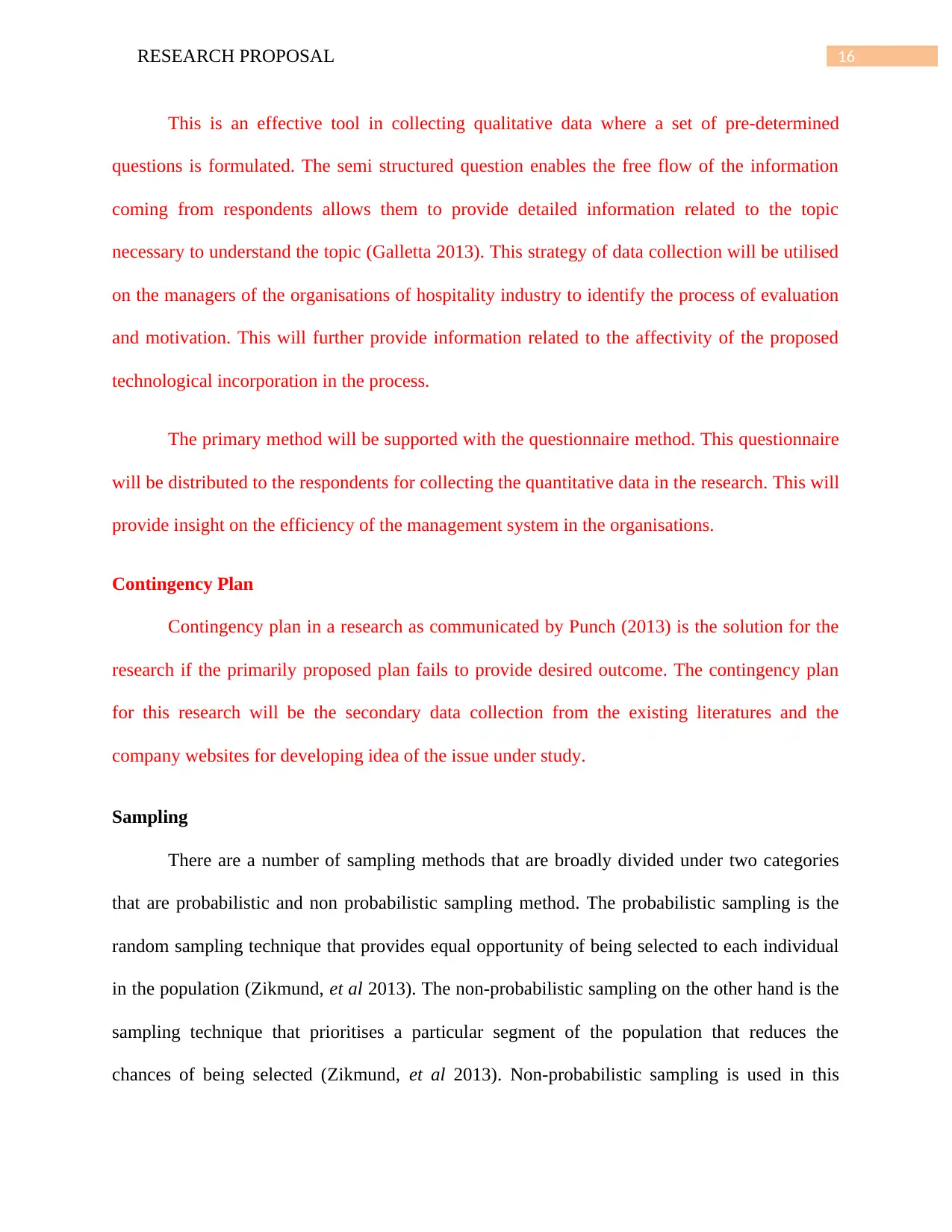
16RESEARCH PROPOSAL
This is an effective tool in collecting qualitative data where a set of pre-determined
questions is formulated. The semi structured question enables the free flow of the information
coming from respondents allows them to provide detailed information related to the topic
necessary to understand the topic (Galletta 2013). This strategy of data collection will be utilised
on the managers of the organisations of hospitality industry to identify the process of evaluation
and motivation. This will further provide information related to the affectivity of the proposed
technological incorporation in the process.
The primary method will be supported with the questionnaire method. This questionnaire
will be distributed to the respondents for collecting the quantitative data in the research. This will
provide insight on the efficiency of the management system in the organisations.
Contingency Plan
Contingency plan in a research as communicated by Punch (2013) is the solution for the
research if the primarily proposed plan fails to provide desired outcome. The contingency plan
for this research will be the secondary data collection from the existing literatures and the
company websites for developing idea of the issue under study.
Sampling
There are a number of sampling methods that are broadly divided under two categories
that are probabilistic and non probabilistic sampling method. The probabilistic sampling is the
random sampling technique that provides equal opportunity of being selected to each individual
in the population (Zikmund, et al 2013). The non-probabilistic sampling on the other hand is the
sampling technique that prioritises a particular segment of the population that reduces the
chances of being selected (Zikmund, et al 2013). Non-probabilistic sampling is used in this
This is an effective tool in collecting qualitative data where a set of pre-determined
questions is formulated. The semi structured question enables the free flow of the information
coming from respondents allows them to provide detailed information related to the topic
necessary to understand the topic (Galletta 2013). This strategy of data collection will be utilised
on the managers of the organisations of hospitality industry to identify the process of evaluation
and motivation. This will further provide information related to the affectivity of the proposed
technological incorporation in the process.
The primary method will be supported with the questionnaire method. This questionnaire
will be distributed to the respondents for collecting the quantitative data in the research. This will
provide insight on the efficiency of the management system in the organisations.
Contingency Plan
Contingency plan in a research as communicated by Punch (2013) is the solution for the
research if the primarily proposed plan fails to provide desired outcome. The contingency plan
for this research will be the secondary data collection from the existing literatures and the
company websites for developing idea of the issue under study.
Sampling
There are a number of sampling methods that are broadly divided under two categories
that are probabilistic and non probabilistic sampling method. The probabilistic sampling is the
random sampling technique that provides equal opportunity of being selected to each individual
in the population (Zikmund, et al 2013). The non-probabilistic sampling on the other hand is the
sampling technique that prioritises a particular segment of the population that reduces the
chances of being selected (Zikmund, et al 2013). Non-probabilistic sampling is used in this
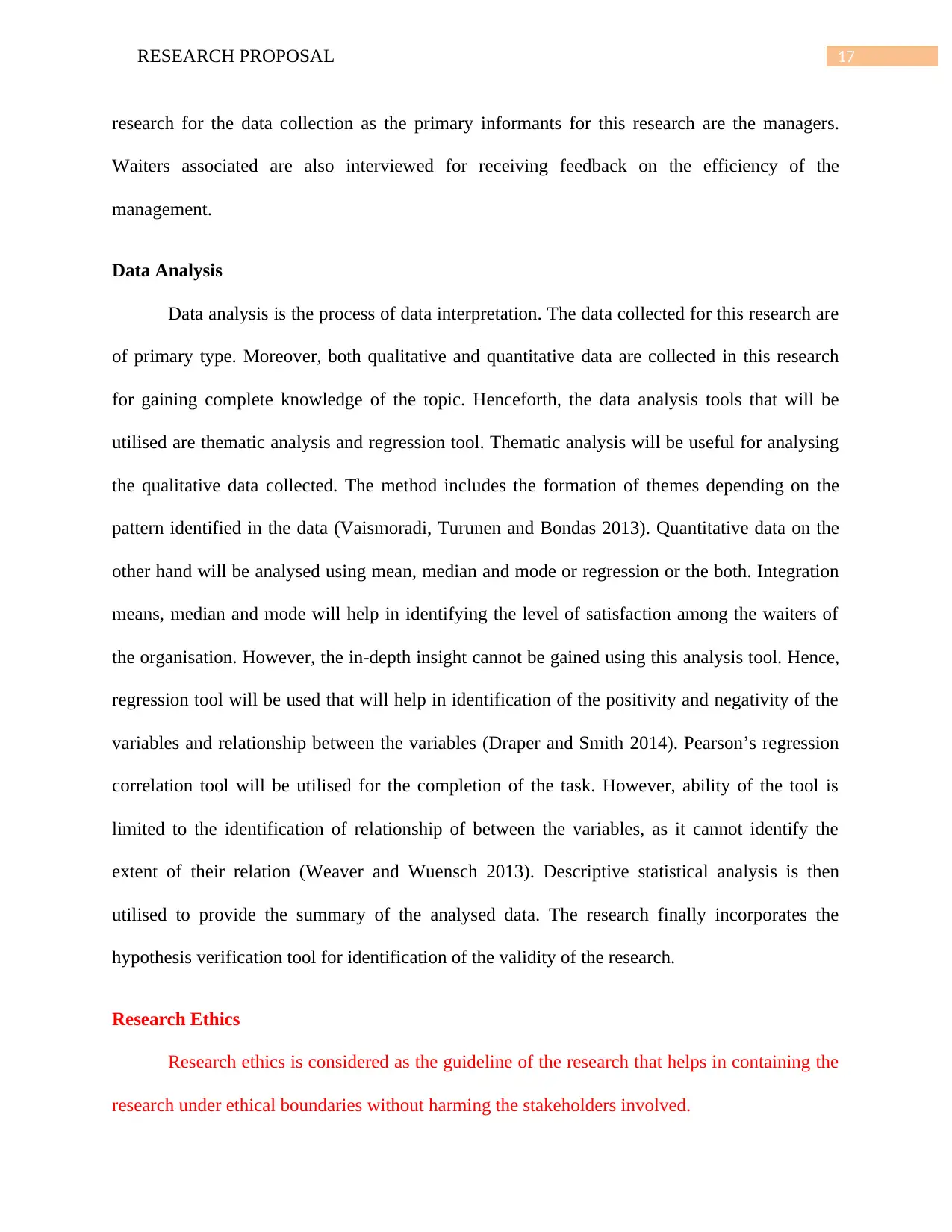
17RESEARCH PROPOSAL
research for the data collection as the primary informants for this research are the managers.
Waiters associated are also interviewed for receiving feedback on the efficiency of the
management.
Data Analysis
Data analysis is the process of data interpretation. The data collected for this research are
of primary type. Moreover, both qualitative and quantitative data are collected in this research
for gaining complete knowledge of the topic. Henceforth, the data analysis tools that will be
utilised are thematic analysis and regression tool. Thematic analysis will be useful for analysing
the qualitative data collected. The method includes the formation of themes depending on the
pattern identified in the data (Vaismoradi, Turunen and Bondas 2013). Quantitative data on the
other hand will be analysed using mean, median and mode or regression or the both. Integration
means, median and mode will help in identifying the level of satisfaction among the waiters of
the organisation. However, the in-depth insight cannot be gained using this analysis tool. Hence,
regression tool will be used that will help in identification of the positivity and negativity of the
variables and relationship between the variables (Draper and Smith 2014). Pearson’s regression
correlation tool will be utilised for the completion of the task. However, ability of the tool is
limited to the identification of relationship of between the variables, as it cannot identify the
extent of their relation (Weaver and Wuensch 2013). Descriptive statistical analysis is then
utilised to provide the summary of the analysed data. The research finally incorporates the
hypothesis verification tool for identification of the validity of the research.
Research Ethics
Research ethics is considered as the guideline of the research that helps in containing the
research under ethical boundaries without harming the stakeholders involved.
research for the data collection as the primary informants for this research are the managers.
Waiters associated are also interviewed for receiving feedback on the efficiency of the
management.
Data Analysis
Data analysis is the process of data interpretation. The data collected for this research are
of primary type. Moreover, both qualitative and quantitative data are collected in this research
for gaining complete knowledge of the topic. Henceforth, the data analysis tools that will be
utilised are thematic analysis and regression tool. Thematic analysis will be useful for analysing
the qualitative data collected. The method includes the formation of themes depending on the
pattern identified in the data (Vaismoradi, Turunen and Bondas 2013). Quantitative data on the
other hand will be analysed using mean, median and mode or regression or the both. Integration
means, median and mode will help in identifying the level of satisfaction among the waiters of
the organisation. However, the in-depth insight cannot be gained using this analysis tool. Hence,
regression tool will be used that will help in identification of the positivity and negativity of the
variables and relationship between the variables (Draper and Smith 2014). Pearson’s regression
correlation tool will be utilised for the completion of the task. However, ability of the tool is
limited to the identification of relationship of between the variables, as it cannot identify the
extent of their relation (Weaver and Wuensch 2013). Descriptive statistical analysis is then
utilised to provide the summary of the analysed data. The research finally incorporates the
hypothesis verification tool for identification of the validity of the research.
Research Ethics
Research ethics is considered as the guideline of the research that helps in containing the
research under ethical boundaries without harming the stakeholders involved.
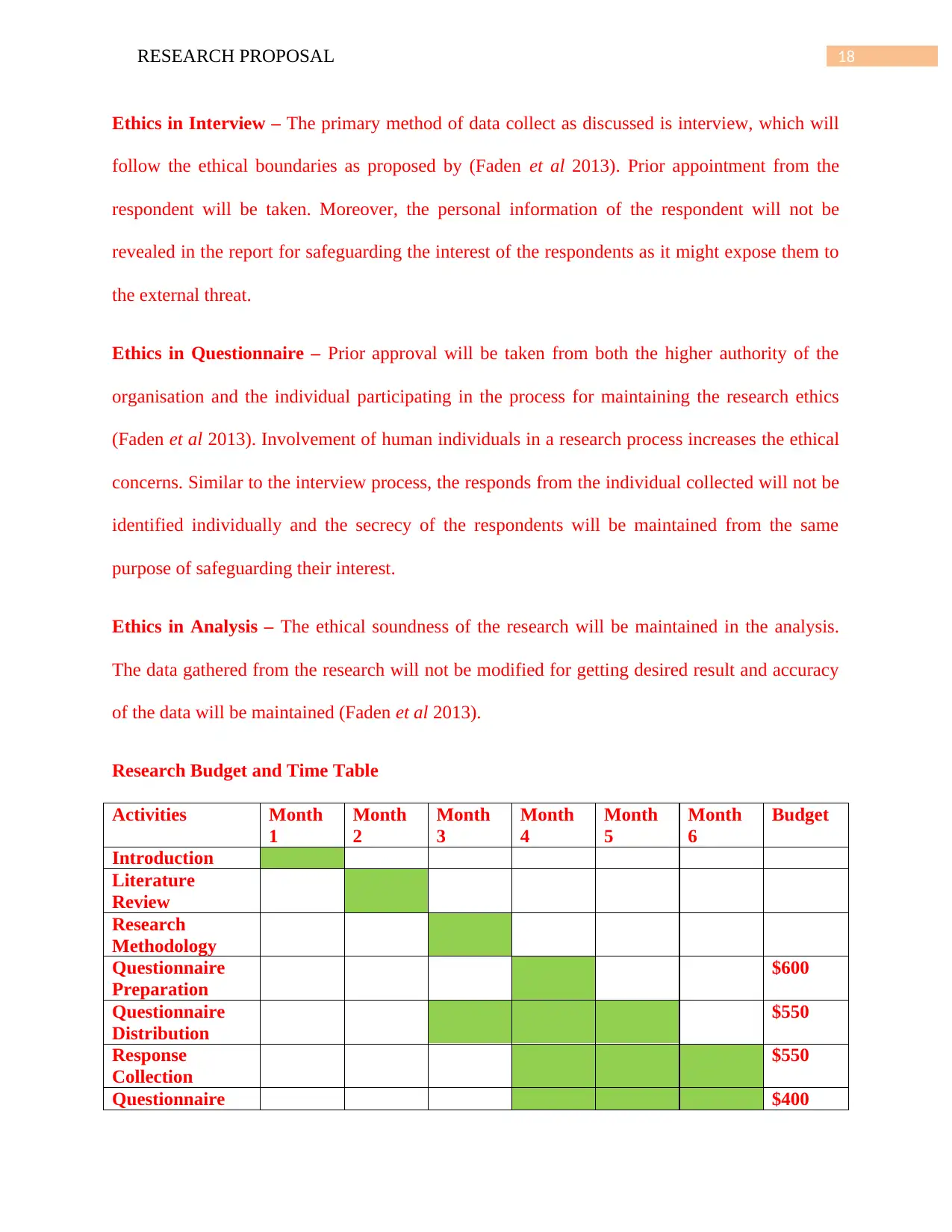
18RESEARCH PROPOSAL
Ethics in Interview – The primary method of data collect as discussed is interview, which will
follow the ethical boundaries as proposed by (Faden et al 2013). Prior appointment from the
respondent will be taken. Moreover, the personal information of the respondent will not be
revealed in the report for safeguarding the interest of the respondents as it might expose them to
the external threat.
Ethics in Questionnaire – Prior approval will be taken from both the higher authority of the
organisation and the individual participating in the process for maintaining the research ethics
(Faden et al 2013). Involvement of human individuals in a research process increases the ethical
concerns. Similar to the interview process, the responds from the individual collected will not be
identified individually and the secrecy of the respondents will be maintained from the same
purpose of safeguarding their interest.
Ethics in Analysis – The ethical soundness of the research will be maintained in the analysis.
The data gathered from the research will not be modified for getting desired result and accuracy
of the data will be maintained (Faden et al 2013).
Research Budget and Time Table
Activities Month
1
Month
2
Month
3
Month
4
Month
5
Month
6
Budget
Introduction
Literature
Review
Research
Methodology
Questionnaire
Preparation
$600
Questionnaire
Distribution
$550
Response
Collection
$550
Questionnaire $400
Ethics in Interview – The primary method of data collect as discussed is interview, which will
follow the ethical boundaries as proposed by (Faden et al 2013). Prior appointment from the
respondent will be taken. Moreover, the personal information of the respondent will not be
revealed in the report for safeguarding the interest of the respondents as it might expose them to
the external threat.
Ethics in Questionnaire – Prior approval will be taken from both the higher authority of the
organisation and the individual participating in the process for maintaining the research ethics
(Faden et al 2013). Involvement of human individuals in a research process increases the ethical
concerns. Similar to the interview process, the responds from the individual collected will not be
identified individually and the secrecy of the respondents will be maintained from the same
purpose of safeguarding their interest.
Ethics in Analysis – The ethical soundness of the research will be maintained in the analysis.
The data gathered from the research will not be modified for getting desired result and accuracy
of the data will be maintained (Faden et al 2013).
Research Budget and Time Table
Activities Month
1
Month
2
Month
3
Month
4
Month
5
Month
6
Budget
Introduction
Literature
Review
Research
Methodology
Questionnaire
Preparation
$600
Questionnaire
Distribution
$550
Response
Collection
$550
Questionnaire $400
Paraphrase This Document
Need a fresh take? Get an instant paraphrase of this document with our AI Paraphraser

19RESEARCH PROPOSAL
Administration
Data Analysis $850
Findings
Conclusion and
Recommendatio
n
Administration
Data Analysis $850
Findings
Conclusion and
Recommendatio
n
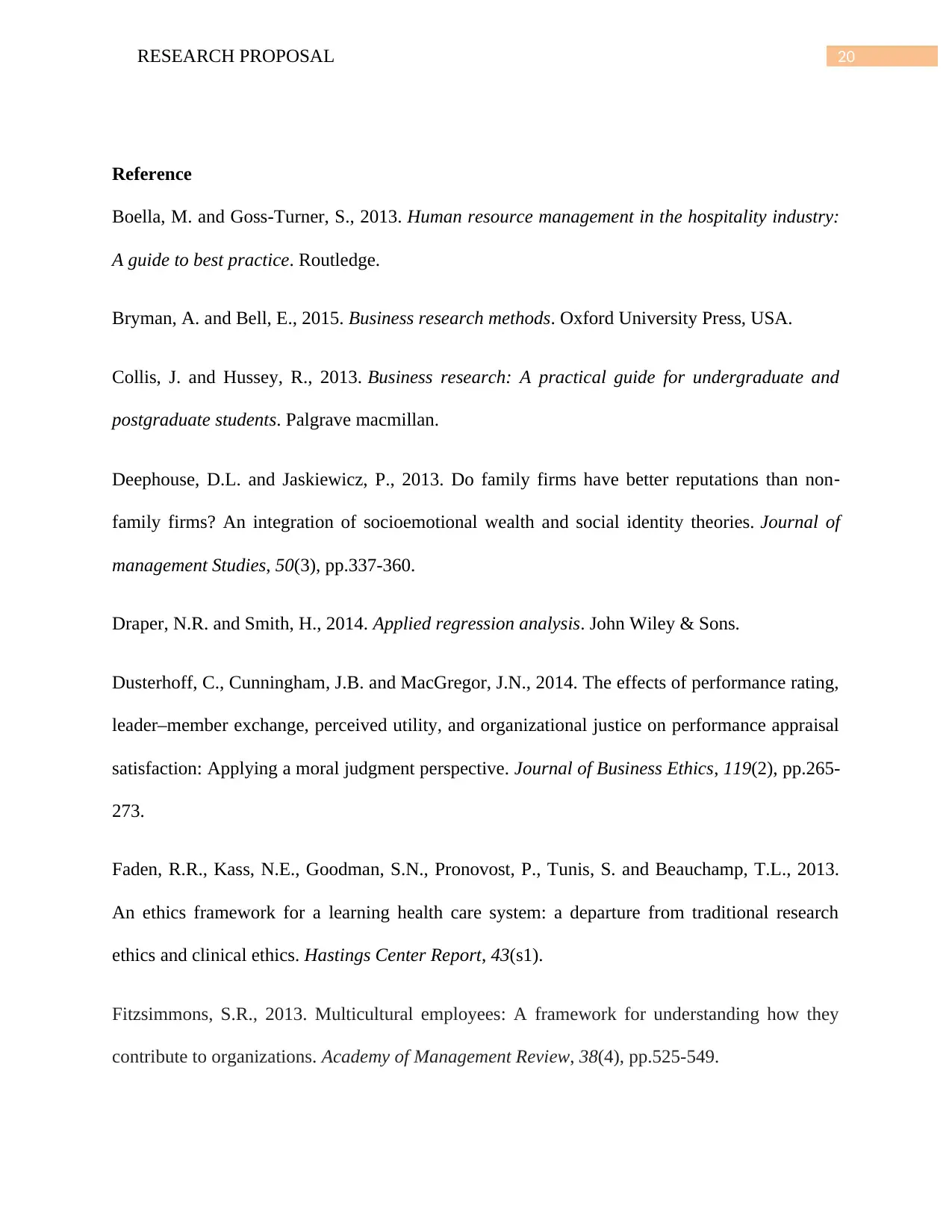
20RESEARCH PROPOSAL
Reference
Boella, M. and Goss-Turner, S., 2013. Human resource management in the hospitality industry:
A guide to best practice. Routledge.
Bryman, A. and Bell, E., 2015. Business research methods. Oxford University Press, USA.
Collis, J. and Hussey, R., 2013. Business research: A practical guide for undergraduate and
postgraduate students. Palgrave macmillan.
Deephouse, D.L. and Jaskiewicz, P., 2013. Do family firms have better reputations than non‐
family firms? An integration of socioemotional wealth and social identity theories. Journal of
management Studies, 50(3), pp.337-360.
Draper, N.R. and Smith, H., 2014. Applied regression analysis. John Wiley & Sons.
Dusterhoff, C., Cunningham, J.B. and MacGregor, J.N., 2014. The effects of performance rating,
leader–member exchange, perceived utility, and organizational justice on performance appraisal
satisfaction: Applying a moral judgment perspective. Journal of Business Ethics, 119(2), pp.265-
273.
Faden, R.R., Kass, N.E., Goodman, S.N., Pronovost, P., Tunis, S. and Beauchamp, T.L., 2013.
An ethics framework for a learning health care system: a departure from traditional research
ethics and clinical ethics. Hastings Center Report, 43(s1).
Fitzsimmons, S.R., 2013. Multicultural employees: A framework for understanding how they
contribute to organizations. Academy of Management Review, 38(4), pp.525-549.
Reference
Boella, M. and Goss-Turner, S., 2013. Human resource management in the hospitality industry:
A guide to best practice. Routledge.
Bryman, A. and Bell, E., 2015. Business research methods. Oxford University Press, USA.
Collis, J. and Hussey, R., 2013. Business research: A practical guide for undergraduate and
postgraduate students. Palgrave macmillan.
Deephouse, D.L. and Jaskiewicz, P., 2013. Do family firms have better reputations than non‐
family firms? An integration of socioemotional wealth and social identity theories. Journal of
management Studies, 50(3), pp.337-360.
Draper, N.R. and Smith, H., 2014. Applied regression analysis. John Wiley & Sons.
Dusterhoff, C., Cunningham, J.B. and MacGregor, J.N., 2014. The effects of performance rating,
leader–member exchange, perceived utility, and organizational justice on performance appraisal
satisfaction: Applying a moral judgment perspective. Journal of Business Ethics, 119(2), pp.265-
273.
Faden, R.R., Kass, N.E., Goodman, S.N., Pronovost, P., Tunis, S. and Beauchamp, T.L., 2013.
An ethics framework for a learning health care system: a departure from traditional research
ethics and clinical ethics. Hastings Center Report, 43(s1).
Fitzsimmons, S.R., 2013. Multicultural employees: A framework for understanding how they
contribute to organizations. Academy of Management Review, 38(4), pp.525-549.
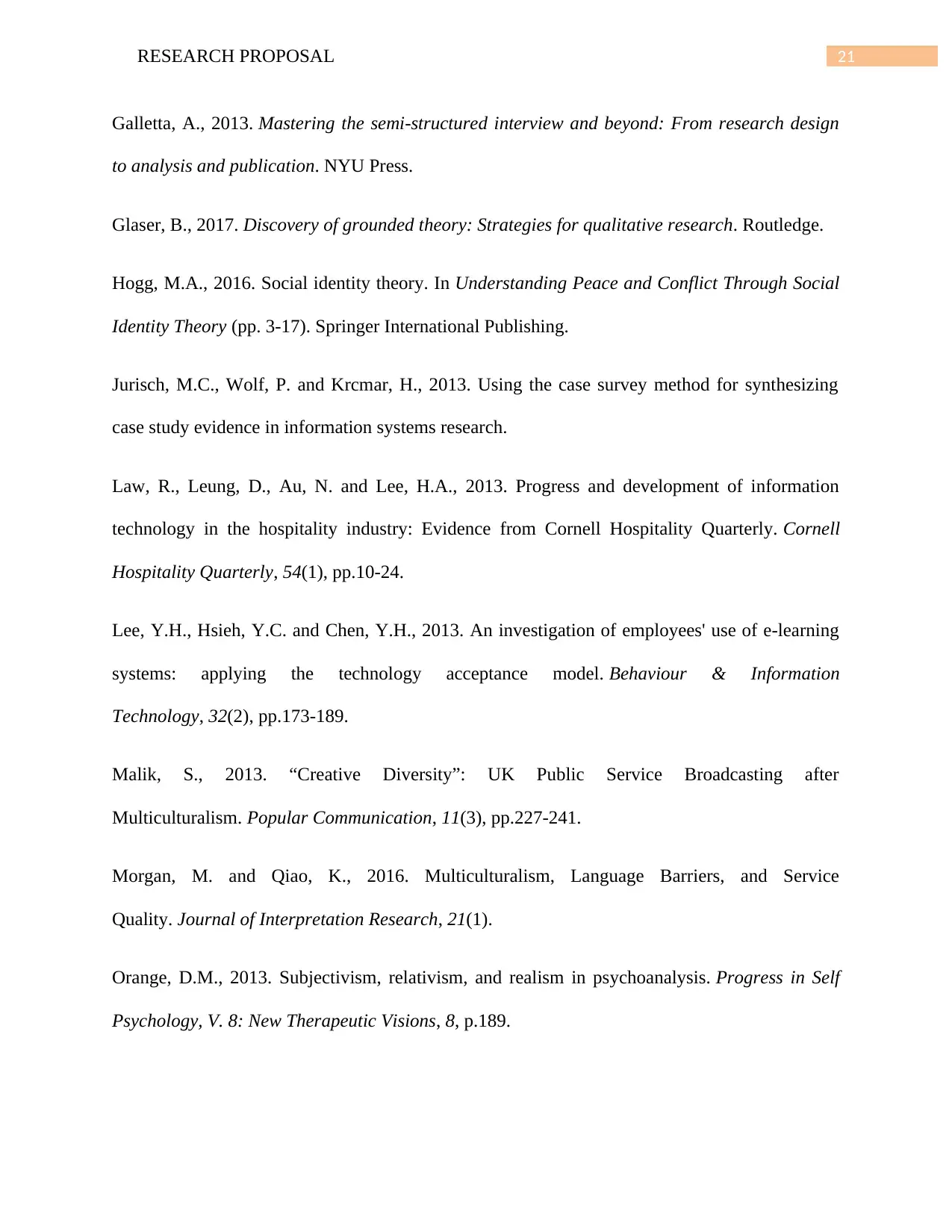
21RESEARCH PROPOSAL
Galletta, A., 2013. Mastering the semi-structured interview and beyond: From research design
to analysis and publication. NYU Press.
Glaser, B., 2017. Discovery of grounded theory: Strategies for qualitative research. Routledge.
Hogg, M.A., 2016. Social identity theory. In Understanding Peace and Conflict Through Social
Identity Theory (pp. 3-17). Springer International Publishing.
Jurisch, M.C., Wolf, P. and Krcmar, H., 2013. Using the case survey method for synthesizing
case study evidence in information systems research.
Law, R., Leung, D., Au, N. and Lee, H.A., 2013. Progress and development of information
technology in the hospitality industry: Evidence from Cornell Hospitality Quarterly. Cornell
Hospitality Quarterly, 54(1), pp.10-24.
Lee, Y.H., Hsieh, Y.C. and Chen, Y.H., 2013. An investigation of employees' use of e-learning
systems: applying the technology acceptance model. Behaviour & Information
Technology, 32(2), pp.173-189.
Malik, S., 2013. “Creative Diversity”: UK Public Service Broadcasting after
Multiculturalism. Popular Communication, 11(3), pp.227-241.
Morgan, M. and Qiao, K., 2016. Multiculturalism, Language Barriers, and Service
Quality. Journal of Interpretation Research, 21(1).
Orange, D.M., 2013. Subjectivism, relativism, and realism in psychoanalysis. Progress in Self
Psychology, V. 8: New Therapeutic Visions, 8, p.189.
Galletta, A., 2013. Mastering the semi-structured interview and beyond: From research design
to analysis and publication. NYU Press.
Glaser, B., 2017. Discovery of grounded theory: Strategies for qualitative research. Routledge.
Hogg, M.A., 2016. Social identity theory. In Understanding Peace and Conflict Through Social
Identity Theory (pp. 3-17). Springer International Publishing.
Jurisch, M.C., Wolf, P. and Krcmar, H., 2013. Using the case survey method for synthesizing
case study evidence in information systems research.
Law, R., Leung, D., Au, N. and Lee, H.A., 2013. Progress and development of information
technology in the hospitality industry: Evidence from Cornell Hospitality Quarterly. Cornell
Hospitality Quarterly, 54(1), pp.10-24.
Lee, Y.H., Hsieh, Y.C. and Chen, Y.H., 2013. An investigation of employees' use of e-learning
systems: applying the technology acceptance model. Behaviour & Information
Technology, 32(2), pp.173-189.
Malik, S., 2013. “Creative Diversity”: UK Public Service Broadcasting after
Multiculturalism. Popular Communication, 11(3), pp.227-241.
Morgan, M. and Qiao, K., 2016. Multiculturalism, Language Barriers, and Service
Quality. Journal of Interpretation Research, 21(1).
Orange, D.M., 2013. Subjectivism, relativism, and realism in psychoanalysis. Progress in Self
Psychology, V. 8: New Therapeutic Visions, 8, p.189.
Secure Best Marks with AI Grader
Need help grading? Try our AI Grader for instant feedback on your assignments.
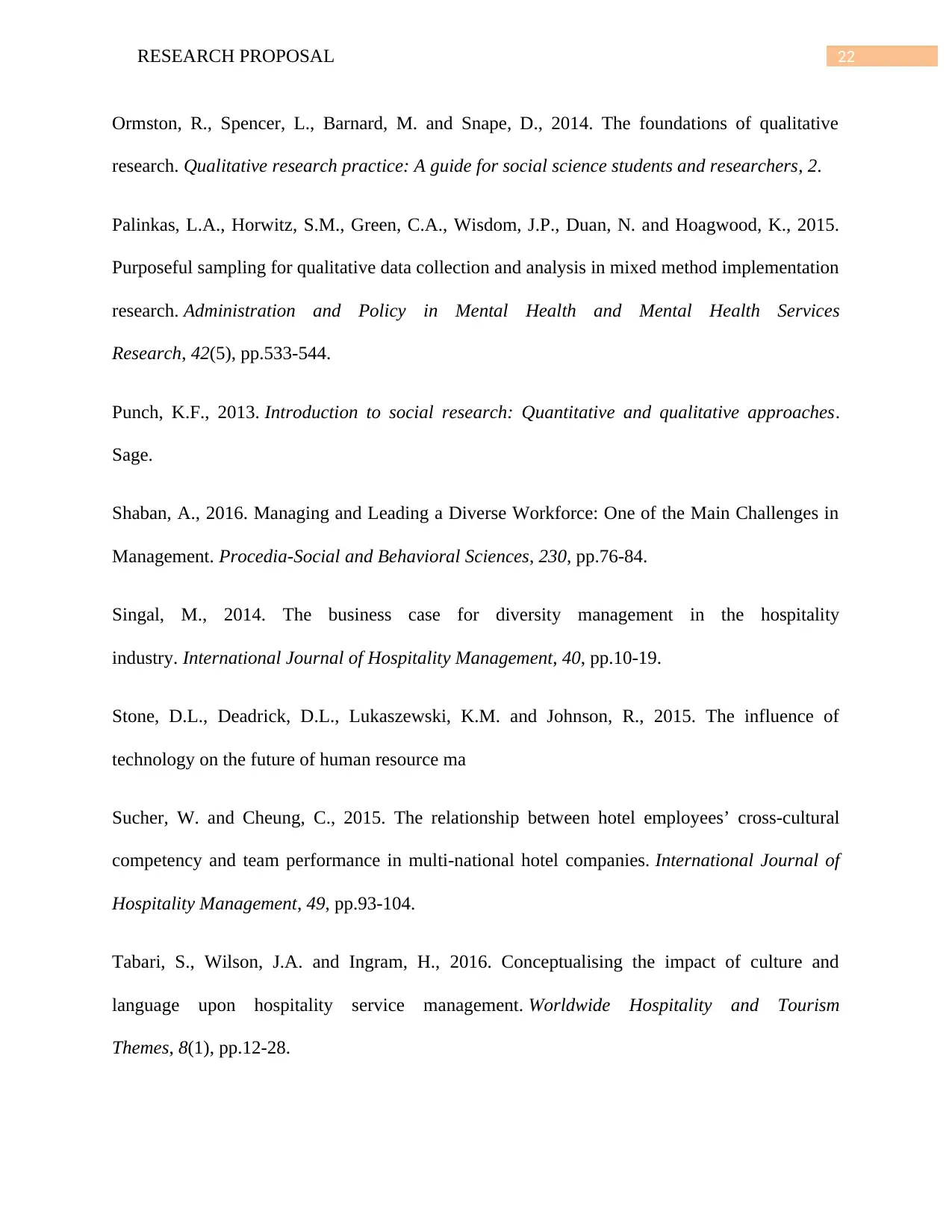
22RESEARCH PROPOSAL
Ormston, R., Spencer, L., Barnard, M. and Snape, D., 2014. The foundations of qualitative
research. Qualitative research practice: A guide for social science students and researchers, 2.
Palinkas, L.A., Horwitz, S.M., Green, C.A., Wisdom, J.P., Duan, N. and Hoagwood, K., 2015.
Purposeful sampling for qualitative data collection and analysis in mixed method implementation
research. Administration and Policy in Mental Health and Mental Health Services
Research, 42(5), pp.533-544.
Punch, K.F., 2013. Introduction to social research: Quantitative and qualitative approaches.
Sage.
Shaban, A., 2016. Managing and Leading a Diverse Workforce: One of the Main Challenges in
Management. Procedia-Social and Behavioral Sciences, 230, pp.76-84.
Singal, M., 2014. The business case for diversity management in the hospitality
industry. International Journal of Hospitality Management, 40, pp.10-19.
Stone, D.L., Deadrick, D.L., Lukaszewski, K.M. and Johnson, R., 2015. The influence of
technology on the future of human resource ma
Sucher, W. and Cheung, C., 2015. The relationship between hotel employees’ cross-cultural
competency and team performance in multi-national hotel companies. International Journal of
Hospitality Management, 49, pp.93-104.
Tabari, S., Wilson, J.A. and Ingram, H., 2016. Conceptualising the impact of culture and
language upon hospitality service management. Worldwide Hospitality and Tourism
Themes, 8(1), pp.12-28.
Ormston, R., Spencer, L., Barnard, M. and Snape, D., 2014. The foundations of qualitative
research. Qualitative research practice: A guide for social science students and researchers, 2.
Palinkas, L.A., Horwitz, S.M., Green, C.A., Wisdom, J.P., Duan, N. and Hoagwood, K., 2015.
Purposeful sampling for qualitative data collection and analysis in mixed method implementation
research. Administration and Policy in Mental Health and Mental Health Services
Research, 42(5), pp.533-544.
Punch, K.F., 2013. Introduction to social research: Quantitative and qualitative approaches.
Sage.
Shaban, A., 2016. Managing and Leading a Diverse Workforce: One of the Main Challenges in
Management. Procedia-Social and Behavioral Sciences, 230, pp.76-84.
Singal, M., 2014. The business case for diversity management in the hospitality
industry. International Journal of Hospitality Management, 40, pp.10-19.
Stone, D.L., Deadrick, D.L., Lukaszewski, K.M. and Johnson, R., 2015. The influence of
technology on the future of human resource ma
Sucher, W. and Cheung, C., 2015. The relationship between hotel employees’ cross-cultural
competency and team performance in multi-national hotel companies. International Journal of
Hospitality Management, 49, pp.93-104.
Tabari, S., Wilson, J.A. and Ingram, H., 2016. Conceptualising the impact of culture and
language upon hospitality service management. Worldwide Hospitality and Tourism
Themes, 8(1), pp.12-28.
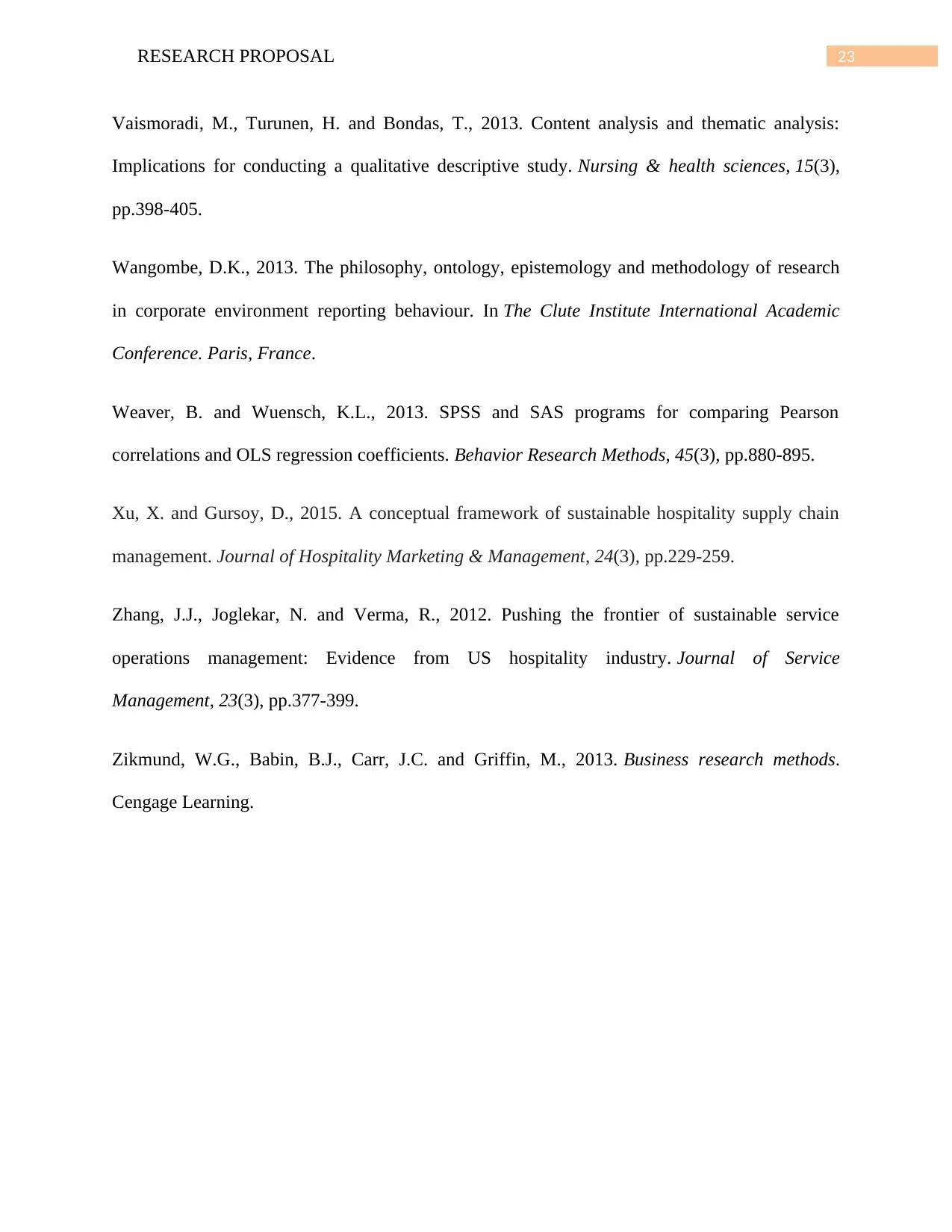
23RESEARCH PROPOSAL
Vaismoradi, M., Turunen, H. and Bondas, T., 2013. Content analysis and thematic analysis:
Implications for conducting a qualitative descriptive study. Nursing & health sciences, 15(3),
pp.398-405.
Wangombe, D.K., 2013. The philosophy, ontology, epistemology and methodology of research
in corporate environment reporting behaviour. In The Clute Institute International Academic
Conference. Paris, France.
Weaver, B. and Wuensch, K.L., 2013. SPSS and SAS programs for comparing Pearson
correlations and OLS regression coefficients. Behavior Research Methods, 45(3), pp.880-895.
Xu, X. and Gursoy, D., 2015. A conceptual framework of sustainable hospitality supply chain
management. Journal of Hospitality Marketing & Management, 24(3), pp.229-259.
Zhang, J.J., Joglekar, N. and Verma, R., 2012. Pushing the frontier of sustainable service
operations management: Evidence from US hospitality industry. Journal of Service
Management, 23(3), pp.377-399.
Zikmund, W.G., Babin, B.J., Carr, J.C. and Griffin, M., 2013. Business research methods.
Cengage Learning.
Vaismoradi, M., Turunen, H. and Bondas, T., 2013. Content analysis and thematic analysis:
Implications for conducting a qualitative descriptive study. Nursing & health sciences, 15(3),
pp.398-405.
Wangombe, D.K., 2013. The philosophy, ontology, epistemology and methodology of research
in corporate environment reporting behaviour. In The Clute Institute International Academic
Conference. Paris, France.
Weaver, B. and Wuensch, K.L., 2013. SPSS and SAS programs for comparing Pearson
correlations and OLS regression coefficients. Behavior Research Methods, 45(3), pp.880-895.
Xu, X. and Gursoy, D., 2015. A conceptual framework of sustainable hospitality supply chain
management. Journal of Hospitality Marketing & Management, 24(3), pp.229-259.
Zhang, J.J., Joglekar, N. and Verma, R., 2012. Pushing the frontier of sustainable service
operations management: Evidence from US hospitality industry. Journal of Service
Management, 23(3), pp.377-399.
Zikmund, W.G., Babin, B.J., Carr, J.C. and Griffin, M., 2013. Business research methods.
Cengage Learning.
1 out of 24
Related Documents
Your All-in-One AI-Powered Toolkit for Academic Success.
+13062052269
info@desklib.com
Available 24*7 on WhatsApp / Email
![[object Object]](/_next/static/media/star-bottom.7253800d.svg)
Unlock your academic potential
© 2024 | Zucol Services PVT LTD | All rights reserved.





